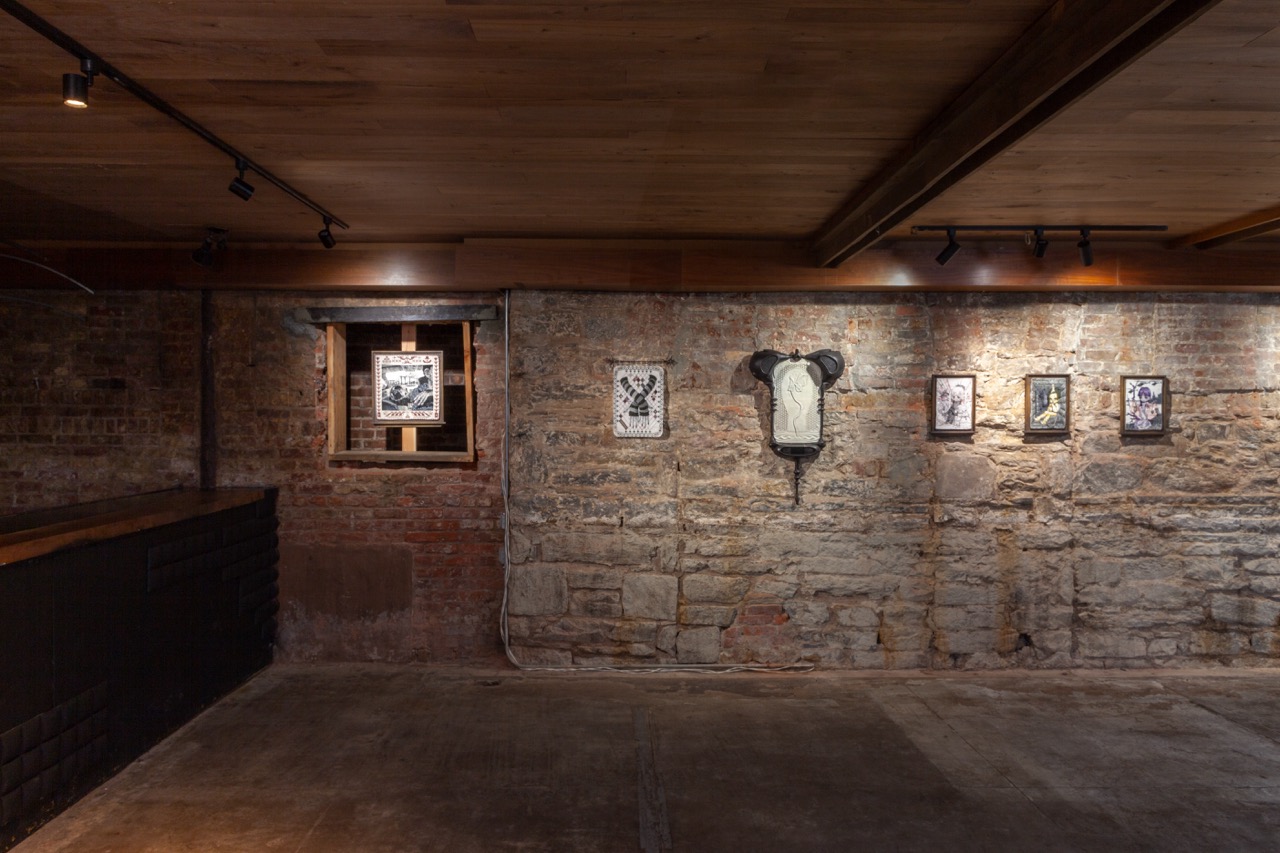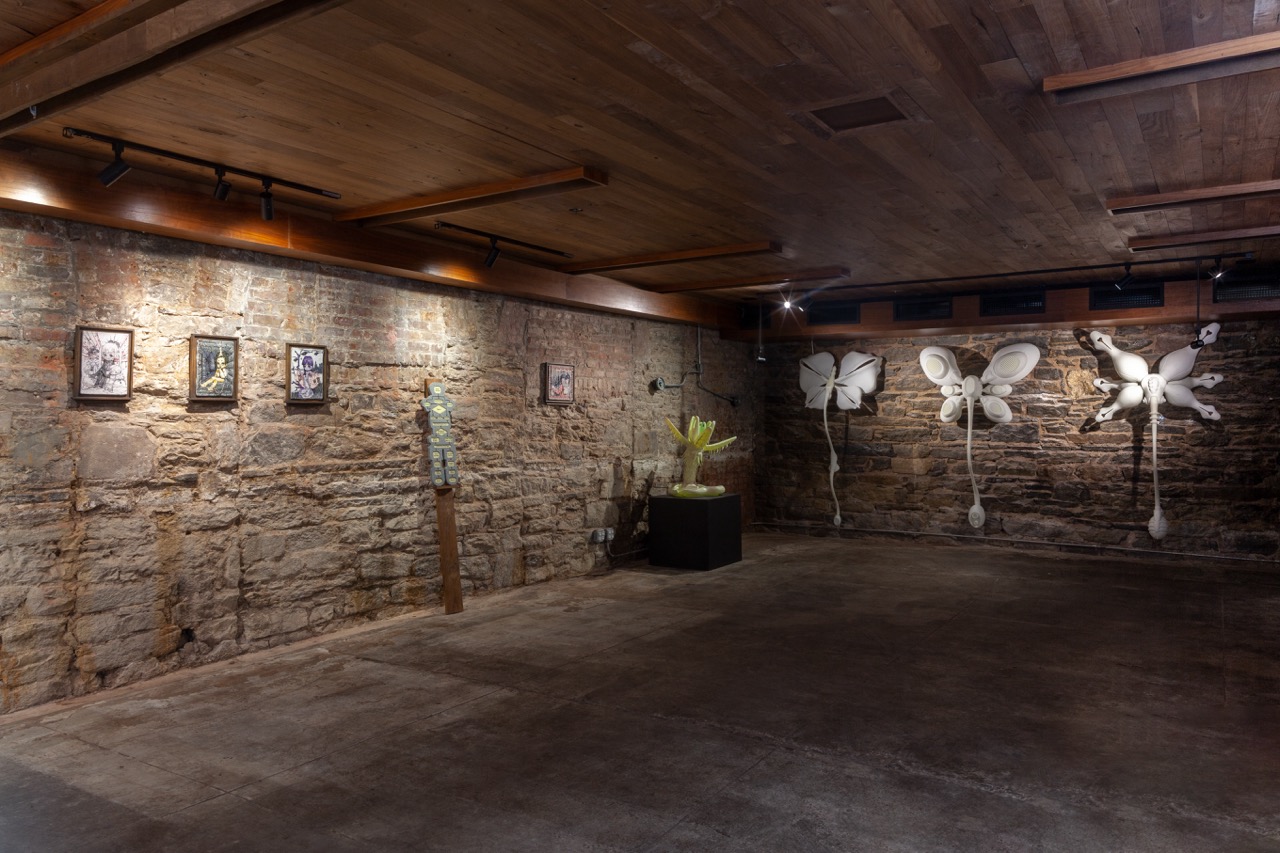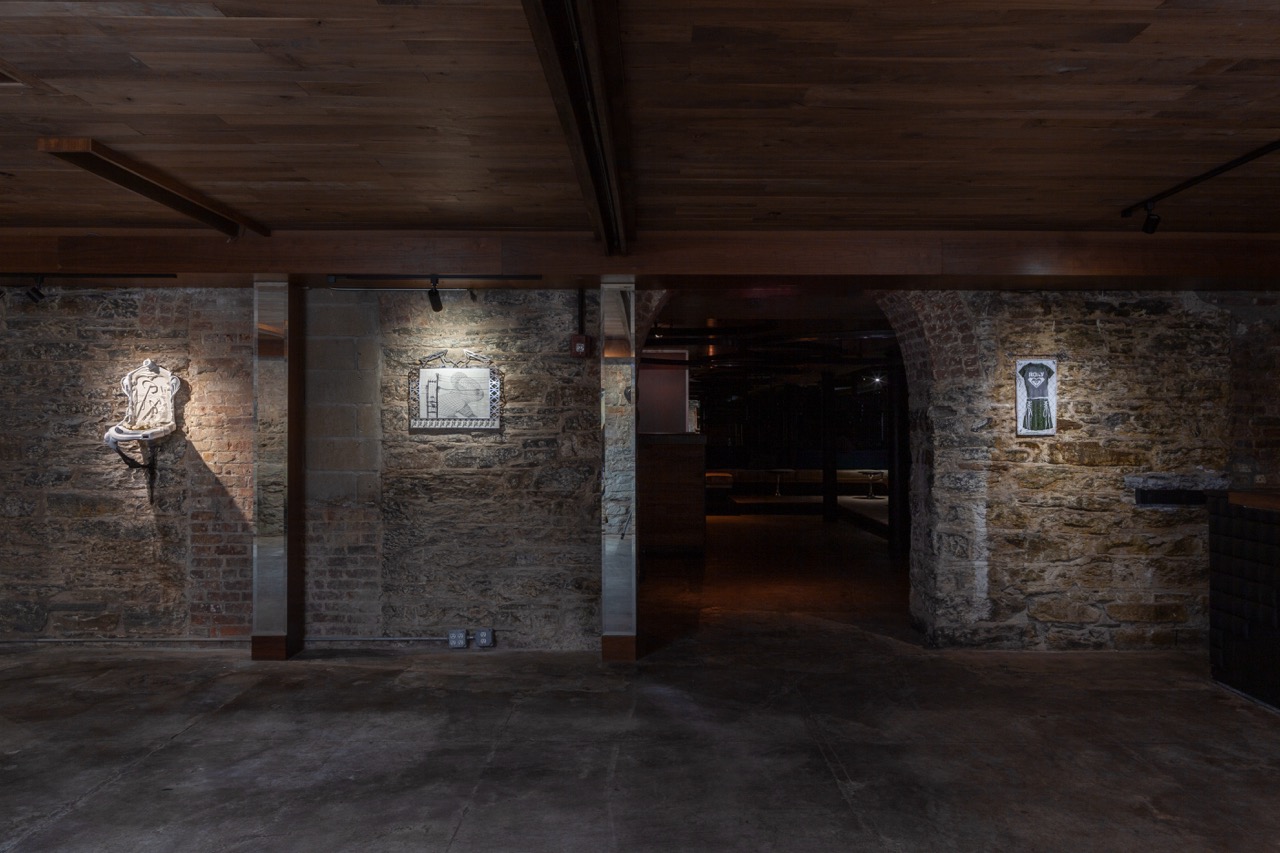Laws of Motion
Preview some of the pieces, below.
'Laws of Motion' is on view now through March 9 at Gagosian San Francisco.
Lead photo: Jeff Wall, 'Siphoning Fuel,' 2008. © Jeff Wall. All photos courtesy of Gagosian.
Stay informed on our latest news!
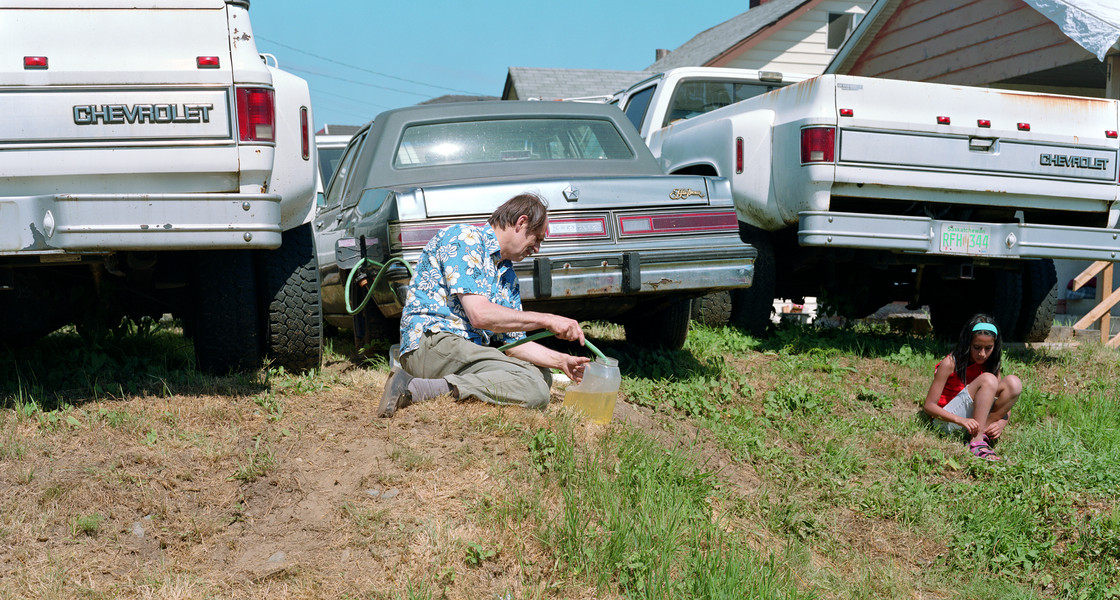
Preview some of the pieces, below.
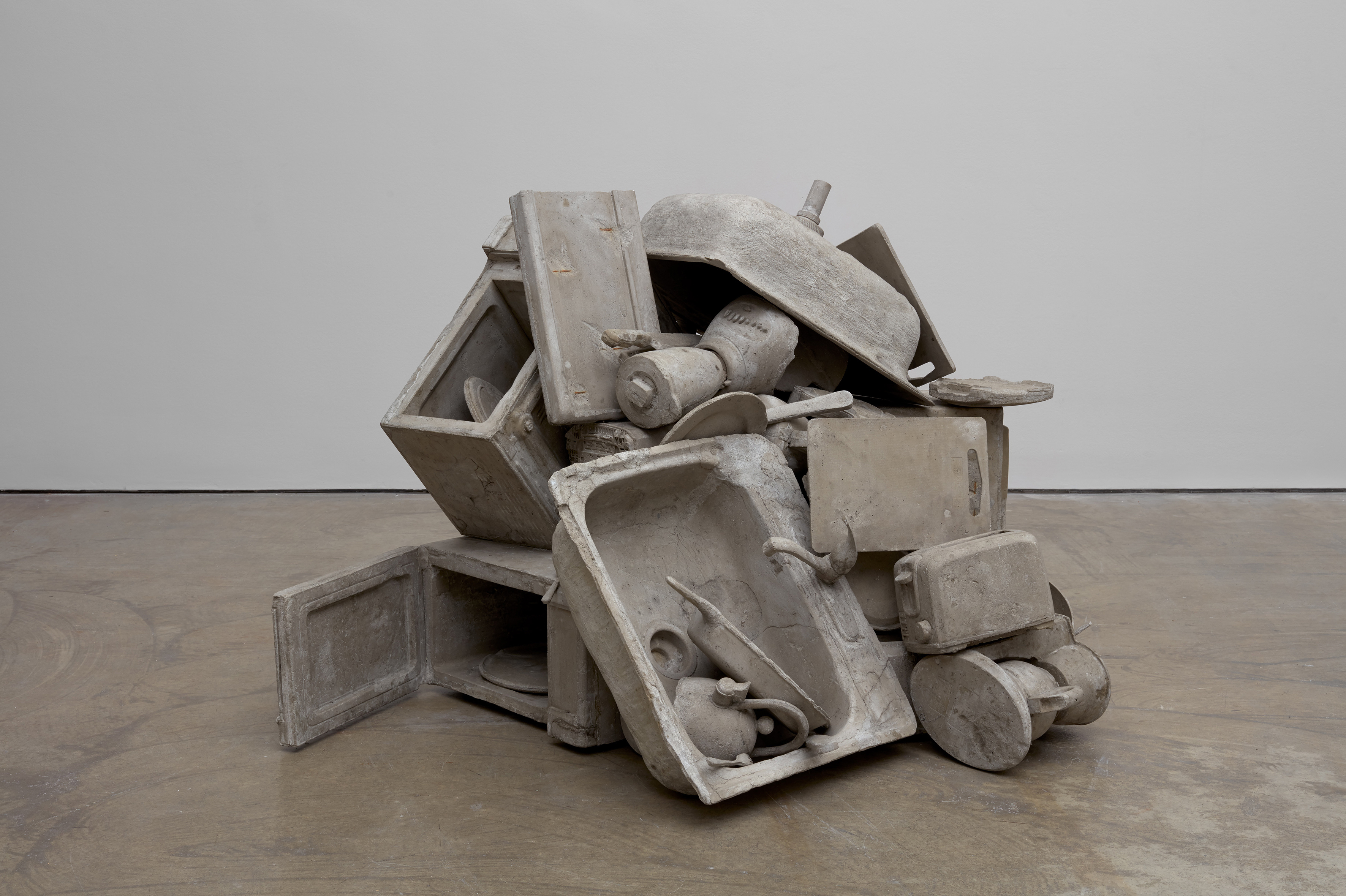
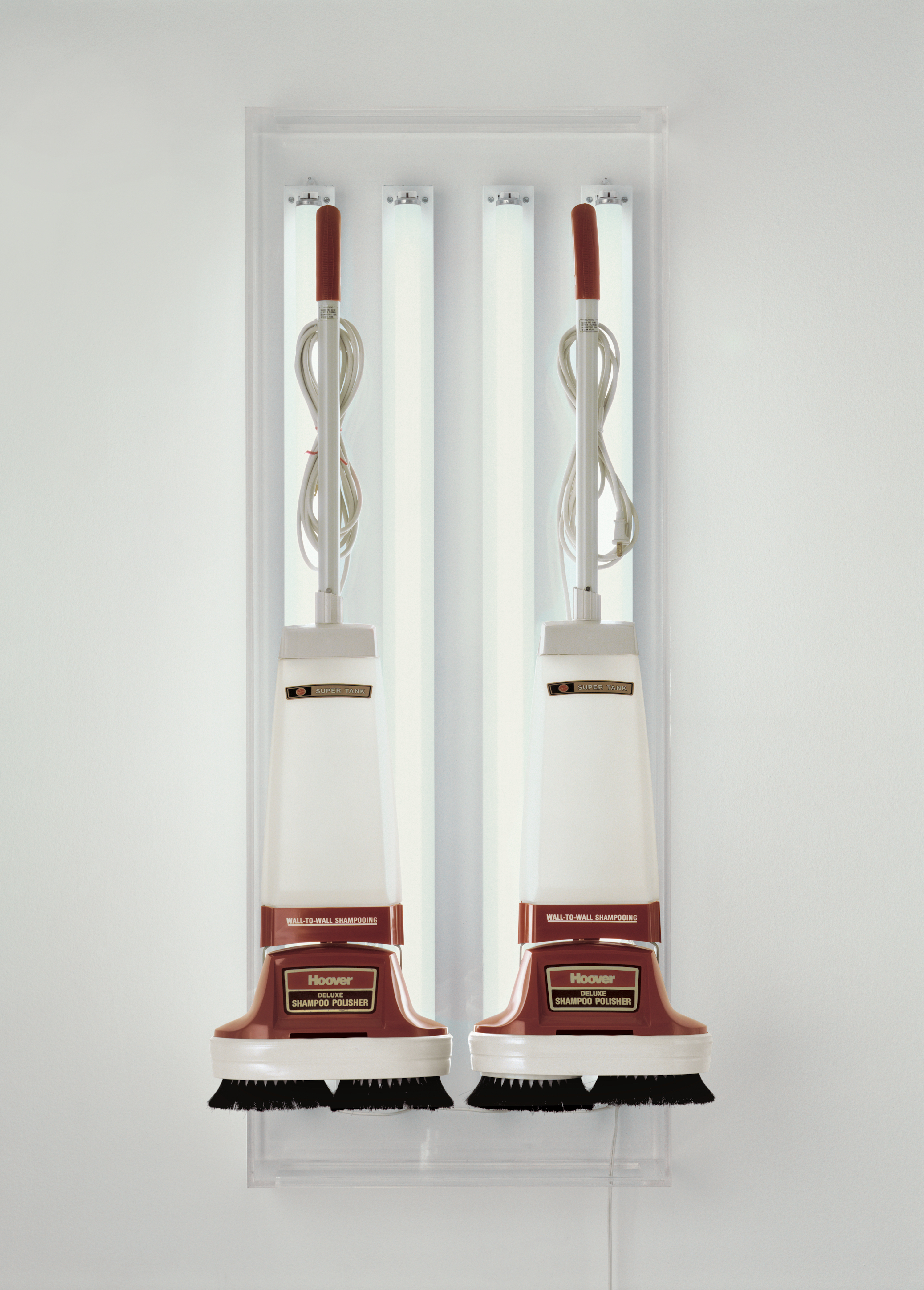
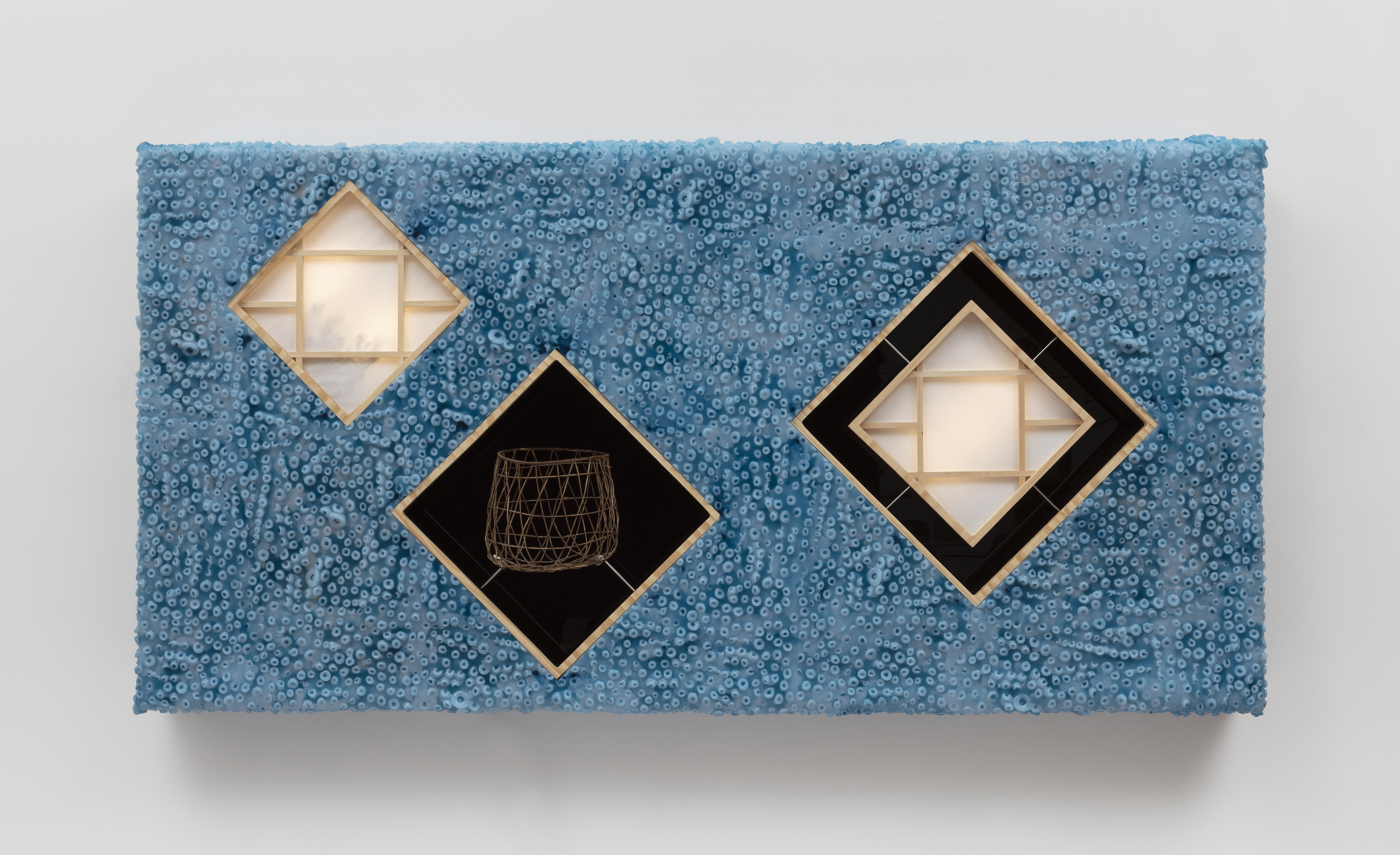
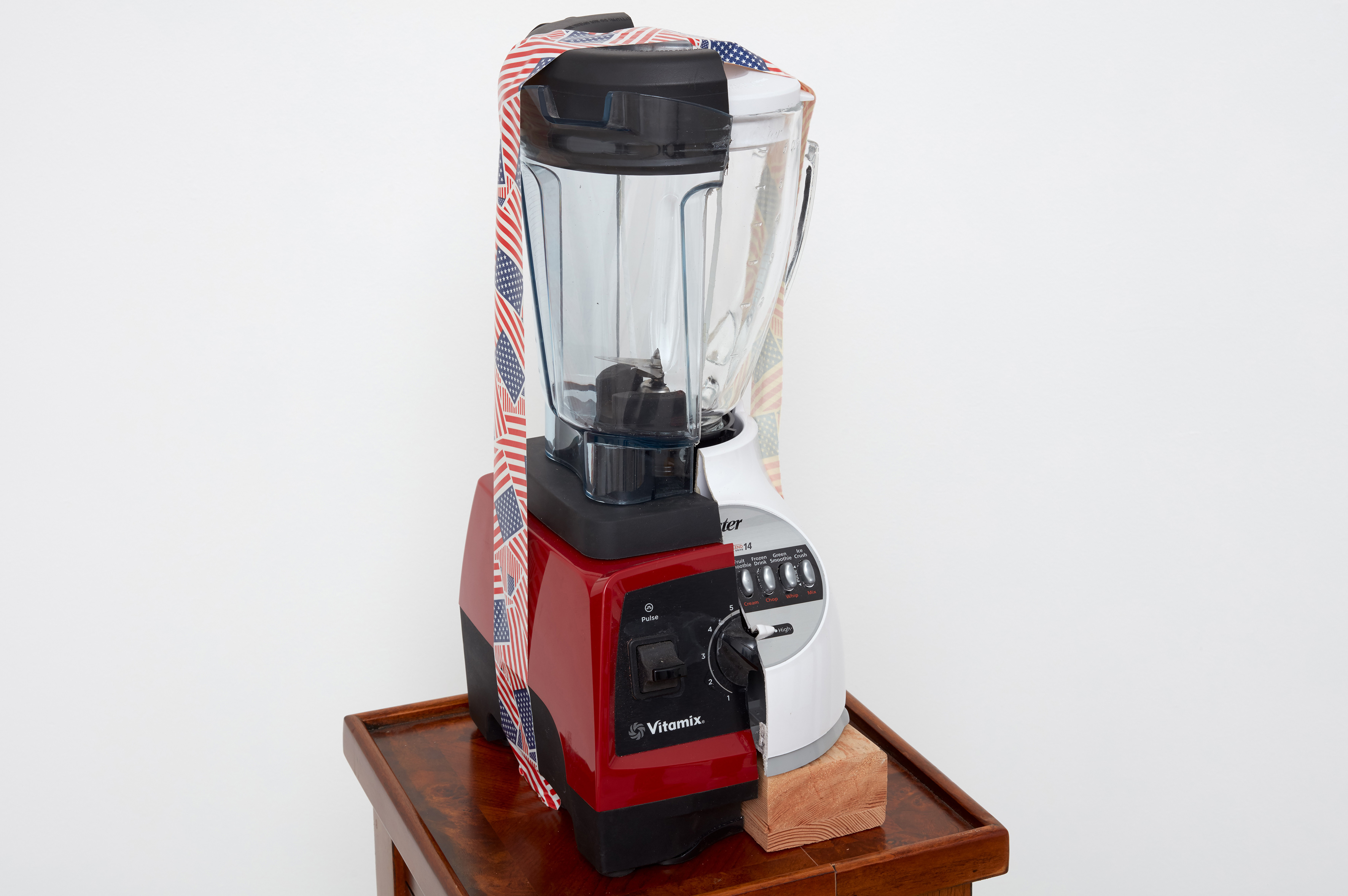
'Laws of Motion' is on view now through March 9 at Gagosian San Francisco.
Lead photo: Jeff Wall, 'Siphoning Fuel,' 2008. © Jeff Wall. All photos courtesy of Gagosian.
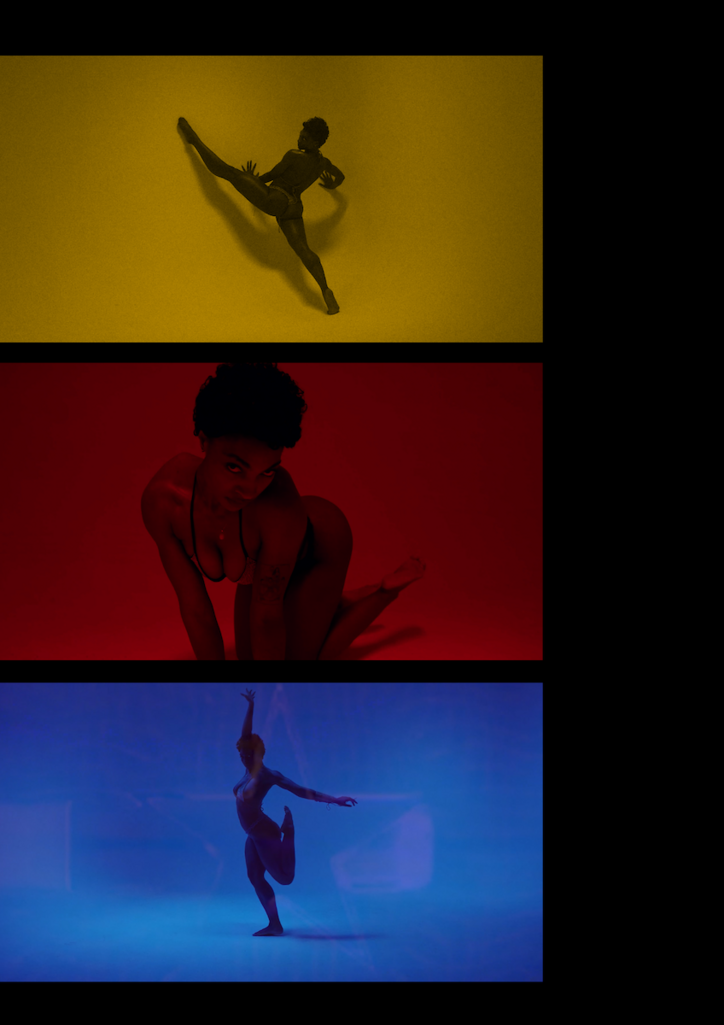
SOL’s resume similarly defies facile categorization; at 19, she co-founded a feminist media company called The Meteor under the direction of former Glamour and Self editor-in-chief Cindi Lieve, for which she served as Multimedia Editor; and as a strategist, she has overseen internal research and international marketing campaigns for companies like Spotify and PBS. She has directed, edited and been featured by publications such as Teen Vogue, Audible, TED, Harper’s Bazaar, and The Hollywood Reporter, and her lectures and writings often channel her personal experiences as a Black woman and a political organizer.
Her latest video project “DRUM GO,” shown in the stills accompanying this interview, is an entirely improvised homage to Black diasporic dance, set to an instrumental by Toro Y Moi. “DRUM GO” complicates mainstream portrayals of Black female sexuality as deviant and low-brow, “paying homage to black eroticism's cultural prominance dating back to ancient African cosmology” through the visual language of fast-cut viral social media clips and 20th century video vixens. “I’m stripping away the last form of branding from being so heavily institutionalized in my thinking and in my creativity, which is essentially the repression of sexuality” SOL says. “I've had my intelligence constantly undermined — there's a humility and a modesty that is imposed upon you as a woman. I’d become ashamed of my sex appeal as I pursued higher education and more prestigious, sophisticated spaces. This is a renunciation of that shame.”
SOL joined office over Zoom to discuss fun as evidence of freedom, abandoning the rules of her training, and why she calls herself a theorist. Read our conversation below.
In the last year or two, you took a step back from working in media to focus more on your art practice, both within your dance and your other mediums. What led you to making that decision? Now that your focus is there, how has the relationship evolved between your more tangible art practice and your other work, like speaking engagements and producing?
I am someone who is a student by nature. I really prefer to just get into the weeds and understand things on a technical and theoretical scale. So even though I had gone to performing art school my entire life, and then continued to train professionally and tour as a dancer by the time I was a senior in high school, I started to become interested in filmmaking when I transferred to Harvard from Middlebury. I abandoned the degree I was already pursuing. I started to study film because I wanted to know it in a more robust way, and I didn't want to have to self-teach in something that is super technical. I was always working within artistic mediums very closely because I was in school for them, but I was also working professionally to make money.
I hadn't honed my clarity of what I wanted to say to the world when I started working in media. There was sort of an intersection of my work with activism and my academic theoretical work, but I created this boundary between them in which I was working administratively within media rather than creatively. It was corporatized, so I just used it as a training ground. I got to a place where I'd established myself as a facilitator, established myself within media production, and my strategy work of finding ways to mobilize messaging was proving very effective, so I was getting work in that arena. Financially, the constraints aren't the same for me as they once were. And with that, I was like, ‘I’m ready to show what I actually care about.’
I'm ready to abandon all of the indoctrination of all of my training. There's a super major taboo that says you can only dance until your body gives out when you turn 30, and you can't do anything else if you want to dance. I was told all the time, “you can't go to college if you're going to be a dancer,” from the time I was six years old. It was like, “If you're really good, you're going to apprentice with a company, and then you're gonna get picked up and you're gonna tour and that's going to be your life.”
I just don’t agree with these concessions of having to bound myself in these ways. And so I tried to maintain my training and my facility, which is how it's referred to in dance, as well as possible throughout college. Once I graduated, I was ready to dance again, to dance professionally — and I didn’t give a fuck what anybody said, because my body is in the condition to do it. What I found even more miraculous is that my movement quality and style, which is particular to each dancer, had completely morphed in the absence of being in traditional training spaces. Because I was just out in the world, I don't know the influences that were enacting on my body, but they were changing the way that I moved. Despite having a very rigid classical background, I took to improvisational movement and blending genres and interweaving things and dancing to different scores than what you would traditionally see the movements I was doing paired with. This new nebulous practice just opened up for me. Once I felt more confident in it, I began to share it, and then I began to find work as a dancer.
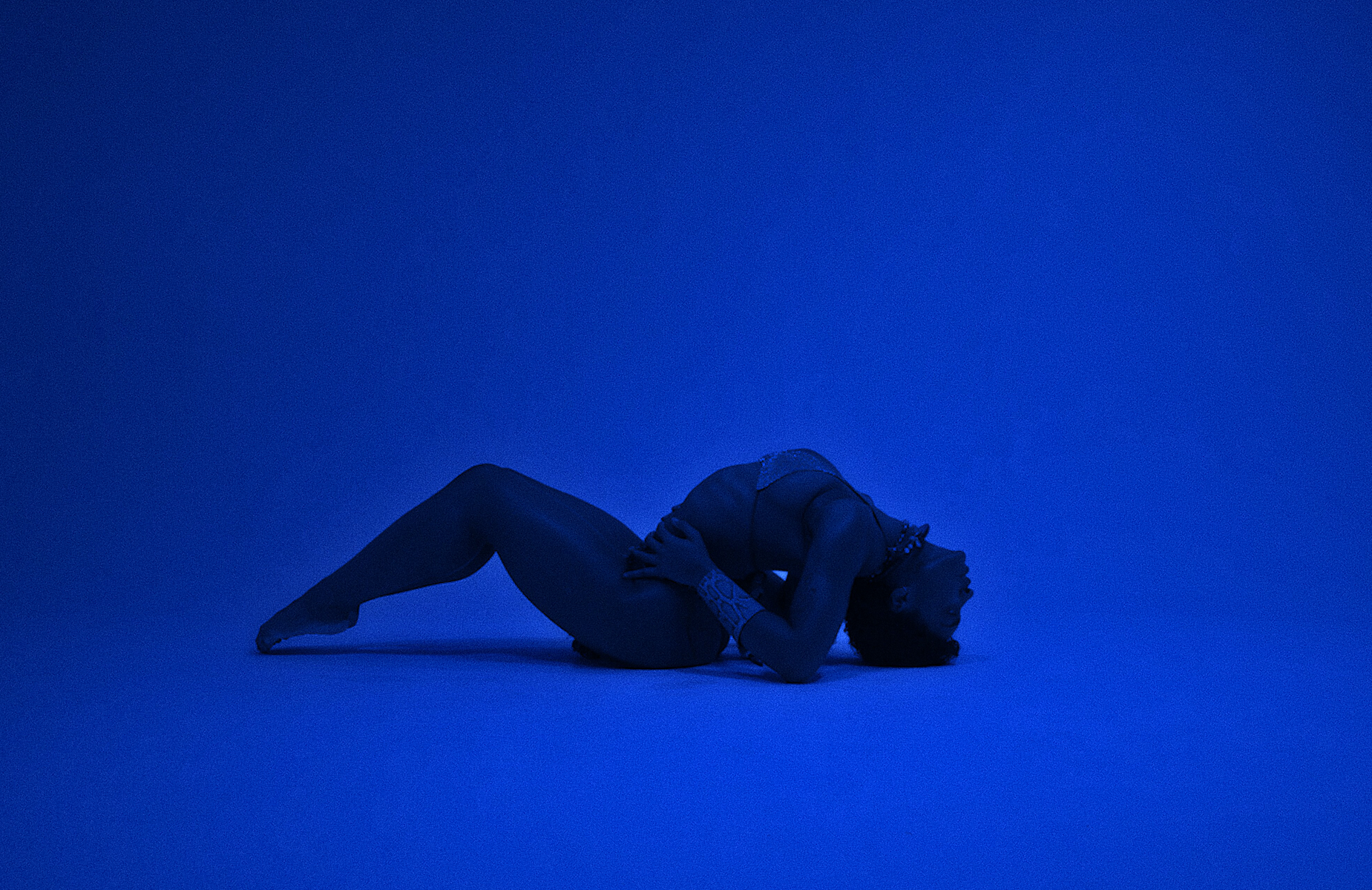
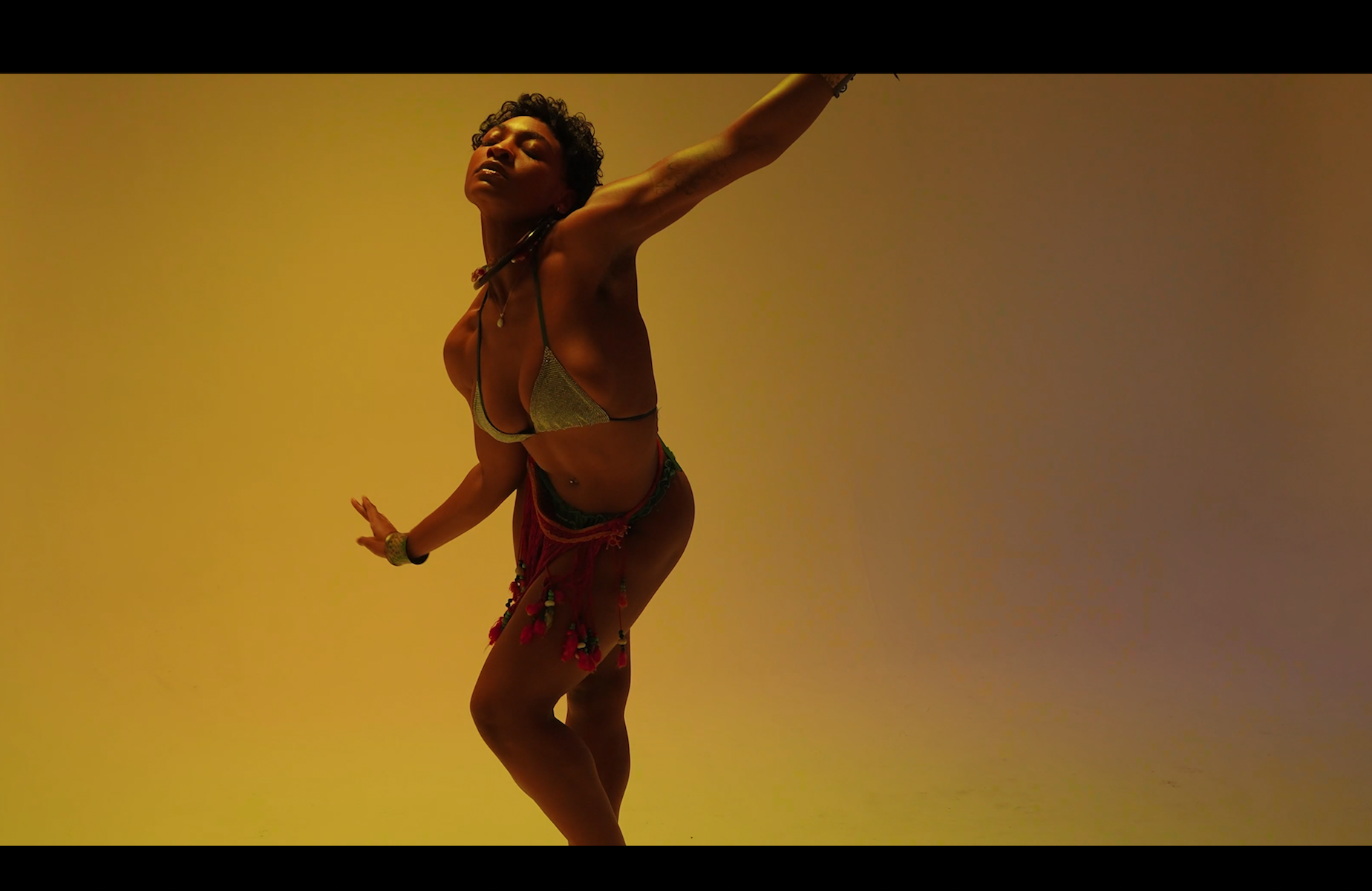
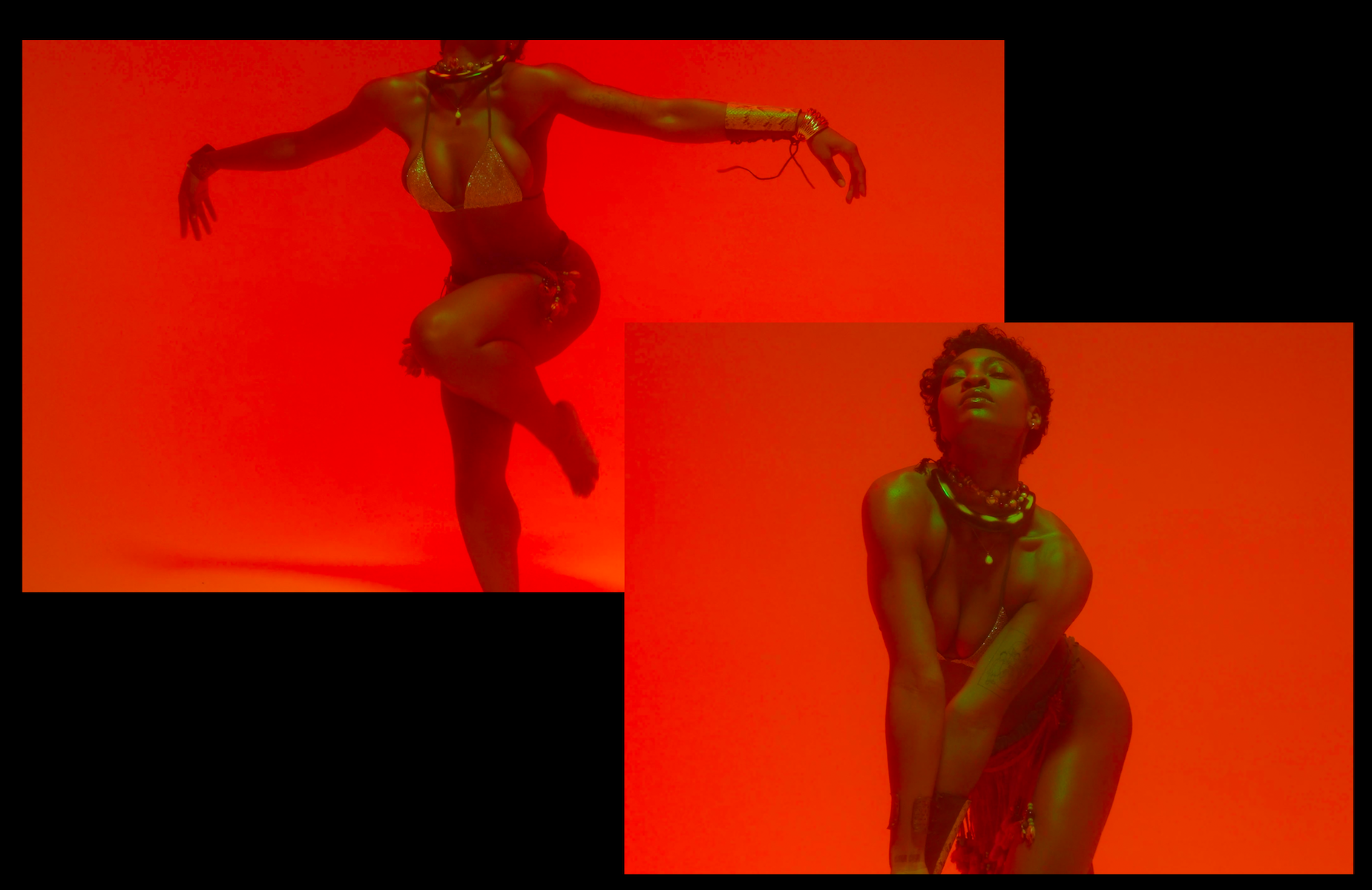
Tell me about this upcoming lecture. What will you be speaking about? What have you spoken about in the past?
This upcoming week, I'm visiting a class that is focused on feminist joy. When I first attended Middlebury, I was studying gender, sexuality and feminist studies, along with history and international politics. I was preparing to create my own major there.This class was created as a response to the symposium last year that I was one of the lecturers for. I'm coming during their unit where they're studying eroticism; they're reading Audre Lorde’s Uses of the Erotic the week that I come, and then the keynote talk I'm doing is called “Deviant and Defiant Love: Paths to Self Fulfillment.” I’ll discuss the ways that rebels, freaks, and outcasts have been the catalyzers of major social and cultural transformations, and participants will reflect on nature as a diagram for cultivating self love and receive tools for overcoming insecurity in pursuit of their greatest potential.
Last year, one talk was called “Fun as Freedom: Alternative Proxies for Feminist Coalition Building,” and another was called “Blood Bound,” that was talking about my organizing work prior to going into media, which was in feminist menstruation activism and anti-poverty work.
For “Fun as Freedom,” though they wanted me initially to discuss my work in media, being the youngest co-founder of this media company with all these mavens, I actually decided to frame the talk around how I abandoned the convention of young professional ambition. The genesis of it was that I had gone through a period in my senior year at Harvard, where I was working full time — I was producing for TED, I took over the guest host role for Brittany Packnet Cunningham on her podcast that I was also a producer on because she was on maternity leave, I was on panels and doing a speaking circuit with one of my co-founders. I was working more than I'd ever worked while I was finishing my senior year. I was also going through a really, really, really hard breakup. I was going crazy. It felt like a really pivotal moment in my life, but I couldn’t really express it because there was an expectation of professionalism that I didn’t want to breach and topple my success thus far.
But something told me I needed to go in the exact opposite direction of my fear. And so I dyed my hair blonde, and I changed my Instagram name to “prettybadass.” I started to throw parties and started to literally introduce people to psychedelics in a really organized manner. I created a punk collective called “Sookie Sookie.” I was so afraid of destroying this one persona of myself that I realized it was critical that I do exactly that, otherwise I would be imprisoned. And so I did the speaking circuit with my bleached blonde hair. I was doing break dancing at this point. There was a lot going on. [Laughs]
But it made me recognize that fun is such an organic sensation. You're either having fun or you're not, and you know it when you feel it. I recognized that in a sense, fun is actually a really good indicator of if you're free, because you can't engender the feeling of fun while you're stressed or anxious or sad or afraid. Even if it's just the intermediary sensation in between these other anxieties, fun is not a comorbidity of stress and sadness. It is the absence of it.
I was doing prison abolitionist work, from the time I worked as a clerk in the public defender's office in Baltimore on their felony division, to my time organizing with Black and Pink, to my independent work. At one point we were doing noise rallies outside of Brooklyn [Metropolitan Detention Center], banging on pots and pans to let the people inside know that we were there for them. That was all it was, and it was fun. During the queer liberation parade during COVID, which wasn't supposed to happen but did anyway, I was photographed by the New York Times dancing — literally me twerking in the street. I've come to realize that this through-line of how I organized and how I went about building coalitions was not based on just collective suffering, but rather wanting to model what liberation looks like even within the confines of these oppressive matrixes.
For this upcoming talk, they came to me and said, ‘this is the unit, what do you think about it?’ And I think that my ministry has really just become rebellion and self sovereignty. Not looking to do these things en masse, but starting with an emancipatory view of yourself. What do you really want? Who are you really, what is your nature? That's why nature is the diagram for autonomy —things in nature operate just as they are, they're not being governed by anything other than how they operate, and everything seems to function.
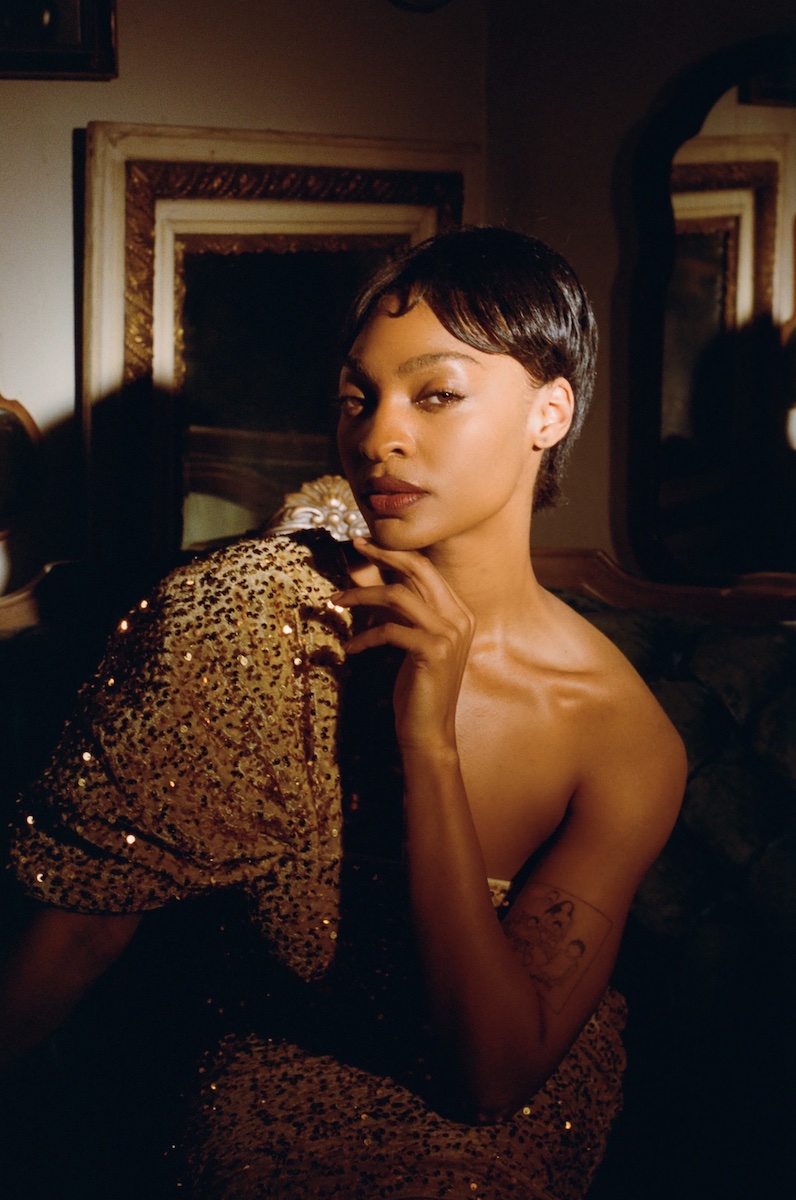
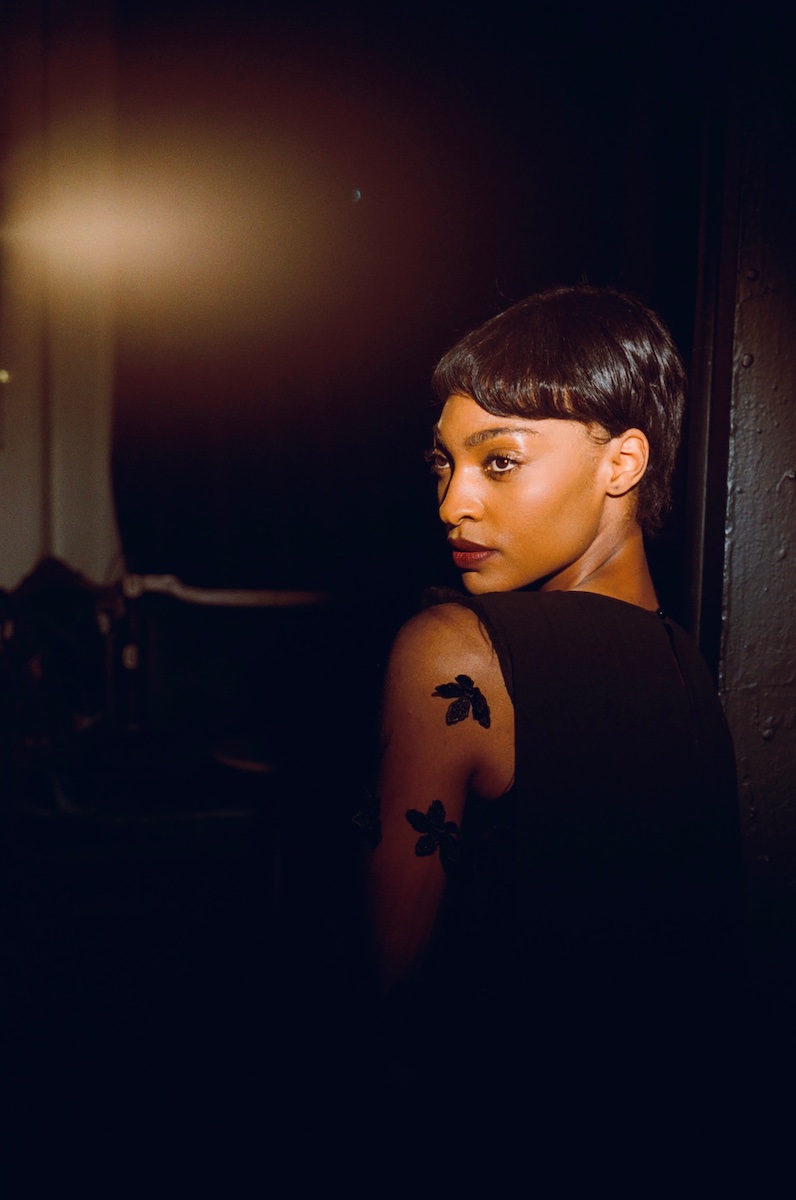
For many years, you did your work relatively behind the scenes, and now you’re very consciously emerging into the spotlight. What caused that shift for you?
There is a very minimal digital footprint of so much of what I've done largely because I remained off of social media for much of my young adulthood. I needed a certain degree of privacy to change and become and experiment without having to be beholden to what I was saying or thinking or feeling.
It's interesting to be reaching a place in my career in which I am so present in the spaces I've aspired to be in, but there's this next leg of what I want to do. I want to reach people and I want to connect with people. I don't feel like I'm in a cocoon of self development anymore, in which I need to be hidden or feel that I don't want to be on the record. I've cultivated my perspective and my voice clearly enough that I'm OK with even the faults and the errors being documented. I want for my gifts and my talents to be recognized, as well as to be able to honor the people who've poured into me and helped establish my career up until this point for me to have the liberties to create the ways that I do with the people that I do. I'm not gonna retreat again until it is that I've attained the shit that I want.
I think you might be the youngest person I've ever heard call themselves a theorist. What does the self-label mean to you, and how do you find that framework helpful?
I wrestle with it because it's not sexy. [Laughs] I'm always sort of teetering a line of over-intellectualization and accessibility, and I don't mean this in terms of language because I am constantly telling people that the foremost critical thinkers in Black theoretical, sociological, and anthropological space were formerly enslaved people. I repeat that notion of accessibility not to mean the thoughts are too lofty, but rather that the label has been so co-opted and made insular to academia, when the most profound theorists I've met came from the hood, every single time. The most profound ideas come from my uncles, they come from my childhood friends, they come from people that are not traditionally educated. That’s why this is a label that I do take pride in, though I understand how it can be alienating. There are people who still understand that their experiences are the raw material of collective understanding. We're at a stage of modernity, where there's so much in recirculation, it feels like everything has been said, every perspective has been seen. I think a lot of people concede to the place of repetition and emulation — we see it in fashion and media, not just with trend cycles, but literally people replicating exact photo shoots. That is a form of becoming motorized, and I resist that.
I think I have perspectives to contribute to the canon. We've never lived at this time. Everything is unprecedented in that way. I'm seeking to make meaning or discover meaning, and to extricate myself from the shame that I may say something wrong — or I may say something new, which is also quite terrifying. In the beginning of Alice Walker's book In Search of Our Mothers’ Gardens, she actually quotes Van Gogh, who said that he was struggling from a scarcity of models. I feel that for myself, as well. I want to canonize my thoughts and my experiences for people who are like me. I feel like there is something revelatory to our individual experiences, and I'm authoring mine.
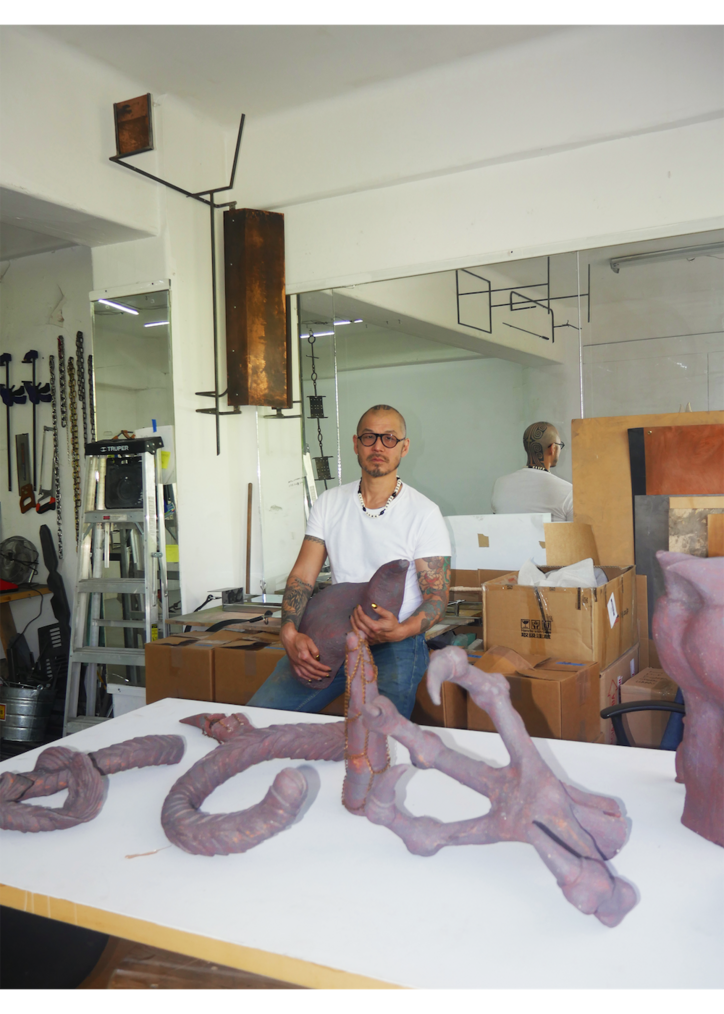
Born in Canada in 1971 to Chinese immigrants, Mao was brought to Michigan as a baby, where he would live until his departure to New York in the 90s. Art has always been a fixture in Mao's life, motivating his decision to study and earn his BFA at The School of the Art Institute of Chicago. The 90s art world was very different than today's, where diasporic voices and artists of color were discounted, either ignored or misunderstood. This culture of exclusivity prompted the then-New York-based artist to acquire skills in foundry work in San Francisco before returning to New York and beginning work at a design-build architecture firm. While simultaneously making art and begging more and more questions, Mao found himself in Mexico City for a residency in 2014 — a city that he now calls home. Mao's life journey has forced him to consider himself in this transnational context, informing much of his work today.
At the beginning of our video chat, Mao mentions how his forthcoming offering at Freize is years in the making. "For the Frieze presentation, I'm basing it on this research that I've been doing for some years now," the contemporary artist explains. "Freemartins" came to be through investigations into Mexicali and its "impenetrable history," a Mexican border town housing the largest Chinese population in the country. In the early twentieth century, coinciding with the Mexican Revolution and exclusionary laws implemented by the United States, the Colorado River Company exploited many Chinese immigrants through work in agriculture and irrigation. The unfamiliar climate and hot summers prompted Chinese workers to build out their basements into a tunnel system, an underground city called "La Chinesca." As the years passed and anti-immigrant sentiment began to spread in Mexico, La Chinesca became a refuge for the city's Chinese population. "Now the tunnel system is only reduced to just these few basements," Mao explains. "I have measurements of these basements. So I use the floor plans of them, and they're cut out of steel plate, and then using that as a basis of the sculptures."
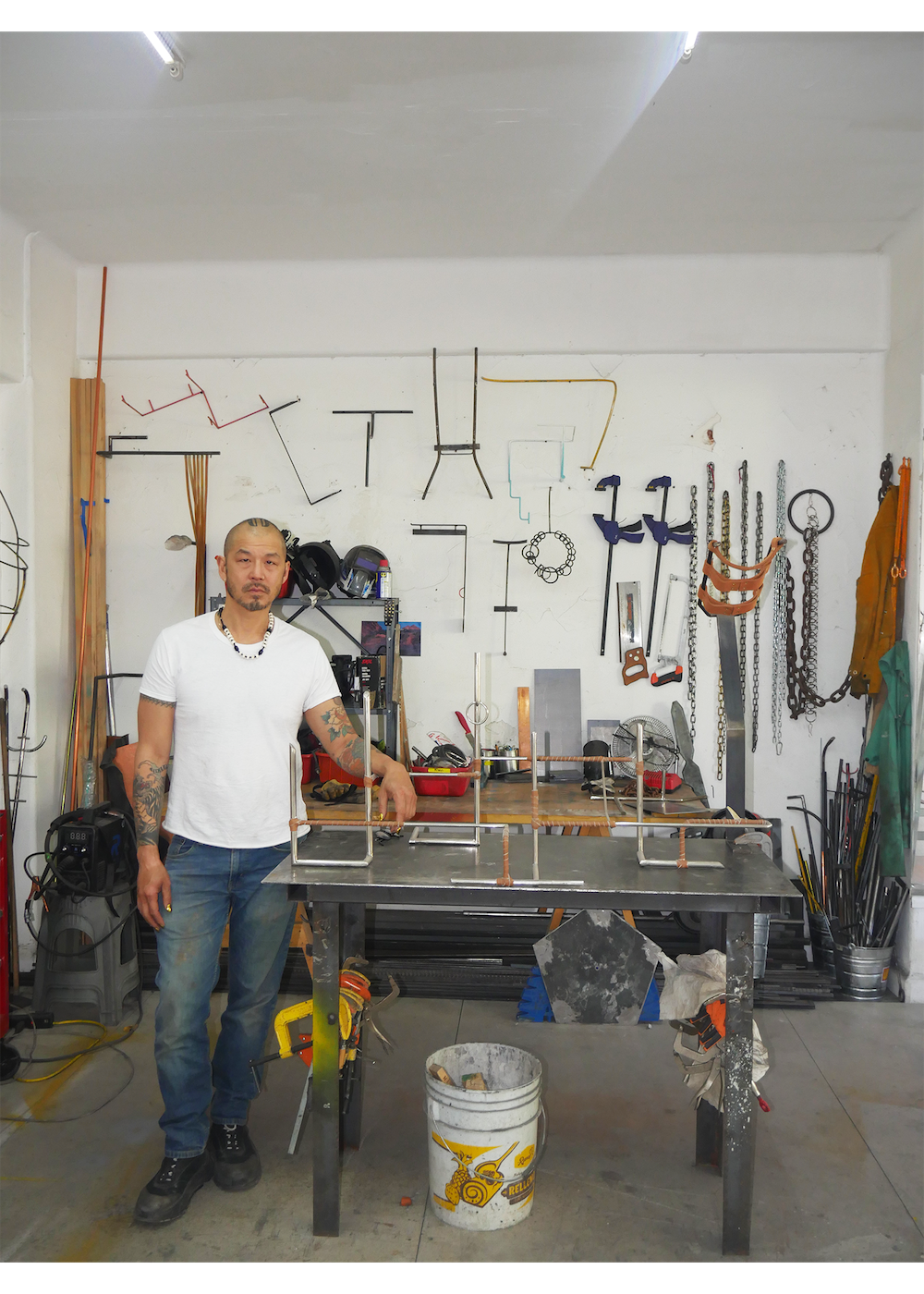
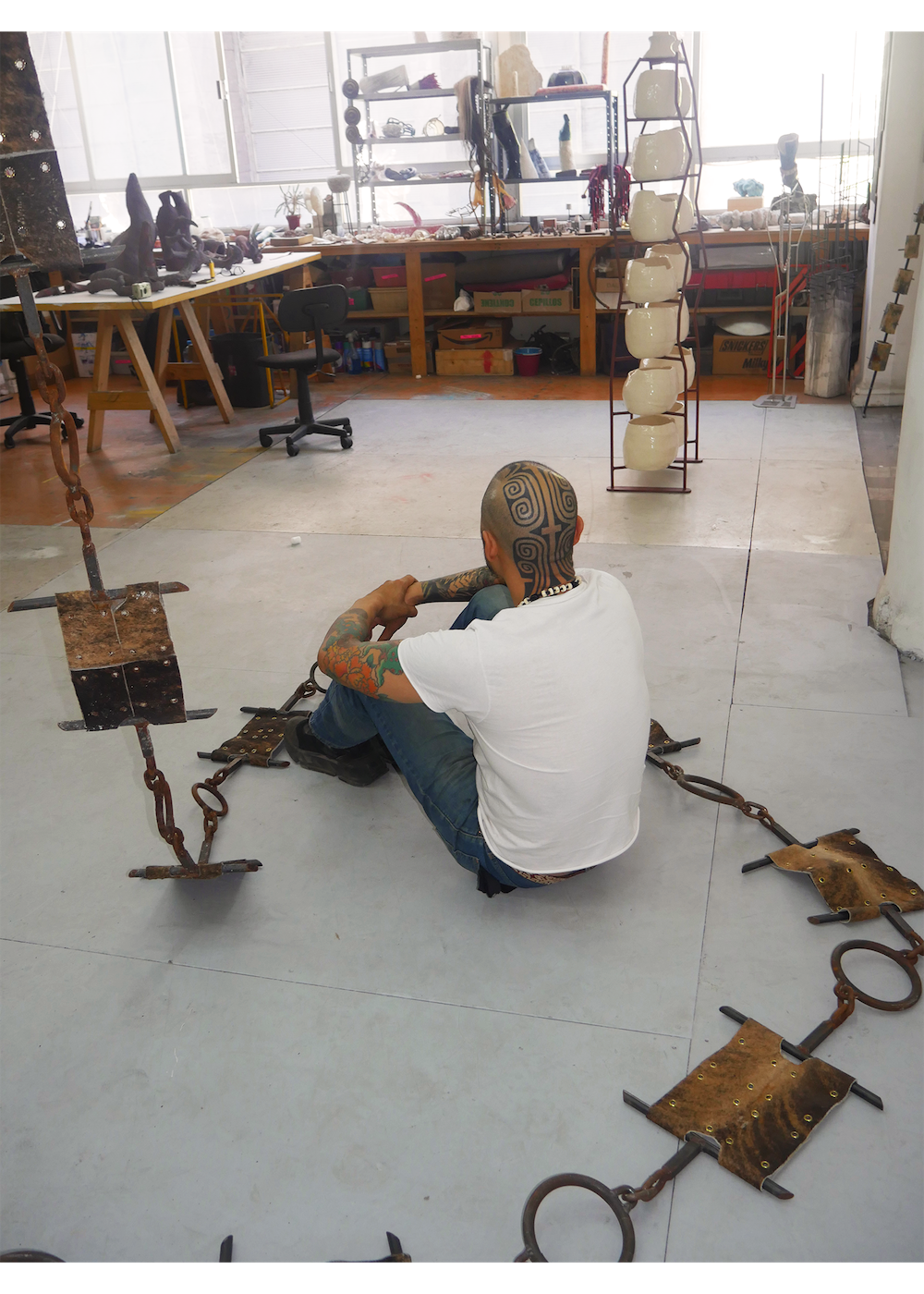
Establishing an underlying — usually nonlinear — narrative is a common thread throughout Mao's practice. After pulling directly from these artifactual spaces, illuminating ideas of liminality, and addressing opaque histories and experiences of diasporic identities, the Mexico City-based artist's approach to this project has provided a basis for much larger ideas. "These floor plans are sort of loosely assembled, so they look like they are coming apart and coming together at the same time. I can use that as the basis for other things, in my practice," Mao states. "Thinking about this orality and the body and architectural space, the dissolution of bodies, and our relationship to myth. This idea that I've been playing with a lot lately of us being related to mythical creatures and sort of relating that to this idea of animism. These animals urge an intelligence of the body — beyond the spiritual mind. All that is sort of inside of these sculptures."
This richness of depth and embedded intentions is apparent not only in the work as a whole, but also in the details and the materials themselves. "[The material] is about this threshold or boundary, decomposition, and composition. I'm thinking about them as material that is moving through time in some way that is breaking apart," the acute artist mentions. "Steel is one of my main materials. Steel is made out of a few elements that have been industrialized into a thing, and then, it's possible that it can rust and disintegrate and go back to the earth." This notion of transience remains a pillar in Mao's practice and an essential facet of "Freemartins," engaging in ideas of fragmented histories, considerations of one's position in nature and the industrial complex, and relationship with time. Fig 39.7 Bardo, the steel armature confines the lava rock, pierces steel bars through the natural material, where a silent dialogue of ephemerality is being had.
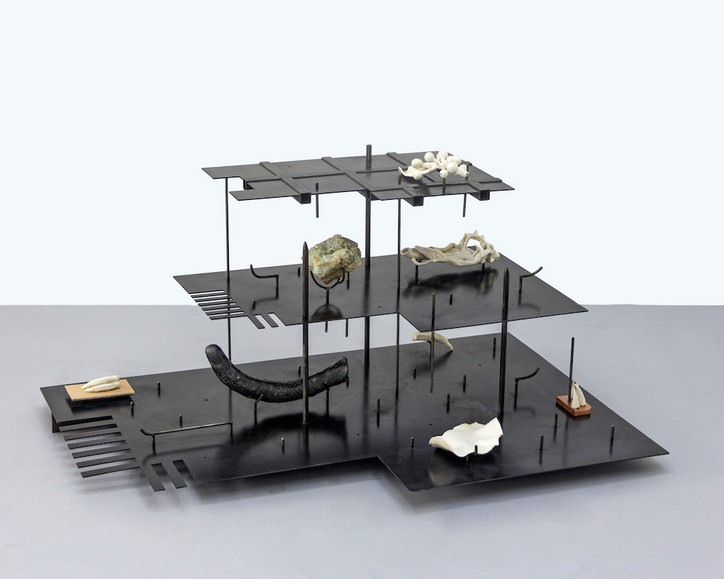
fig 39.1 freemartin, 2024
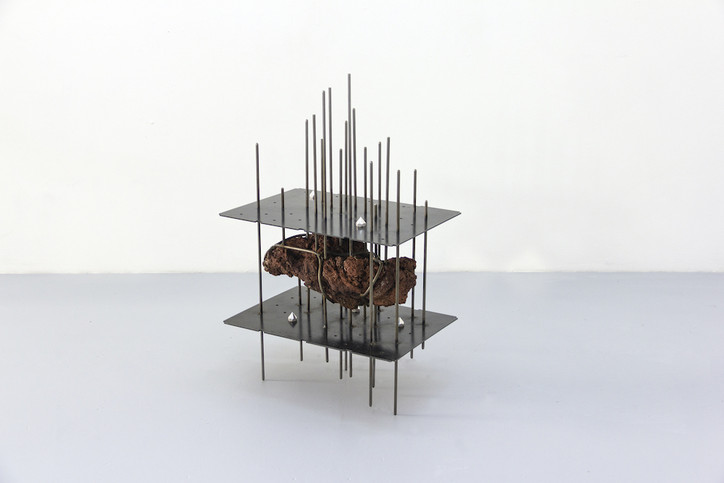
fig 39.7 bardo, 2024
Although Mao's work is laced with conceivable qualities of anthropomorphism and narrative, the work traverses realms of abstraction where discoveries offer more questions than answers. "I really believe in abstraction. And I think that abstraction is hard to talk about. It's hard to write about, but there is this sort of liberation that's happening with abstraction where I can make a figurative sculpture that's not a figure. And it can, therefore, be open enough to talk about all these other things that are happening in the world that may not be as easy to define," Mao states after taking a drag from his cigarette.
Mao's departure in 2015 from the U.S. has allowed for uninhibited artistic freedom — igniting an inner part of himself. "I'm trying to embrace this structure of poetry and this sort of weirdness and abstractness," the esoteric artist states. Since calling CDMX home, Mao has produced incredible work featured in "An array of disruptions and codependencies," in London, "I Desire the strength of nine tigers" in New York, and "Yerba Mala" in Mexico City. Some of his recent work has delved into personal history and ancestral knowledge — a new exploration for the artist. These projects centered on "My mom, dad, and my grandfather, and all this stuff that I had sort of been ignoring, or maybe felt wasn't valid or worth going into," Mao explains. Now, with "Freemartins," an attempt to slowly make his way back into the United States art scene, Mao's subject matter of race, sex, transience, and issues of fragmentation appears as the right entry point to do so. "It feels like it's this sort of, not full circle, maybe a half circle moment," the 52-year-old artist notes.
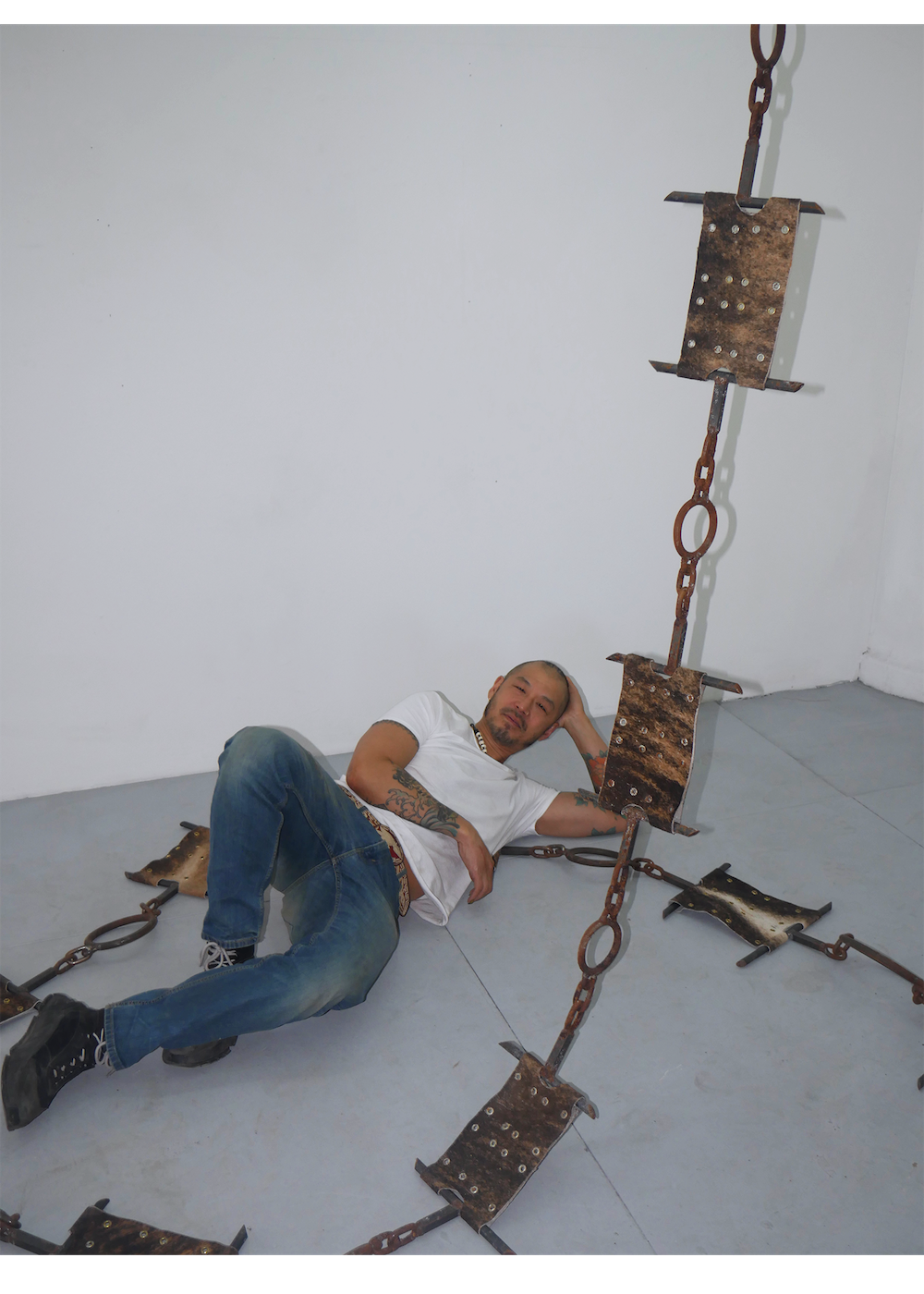
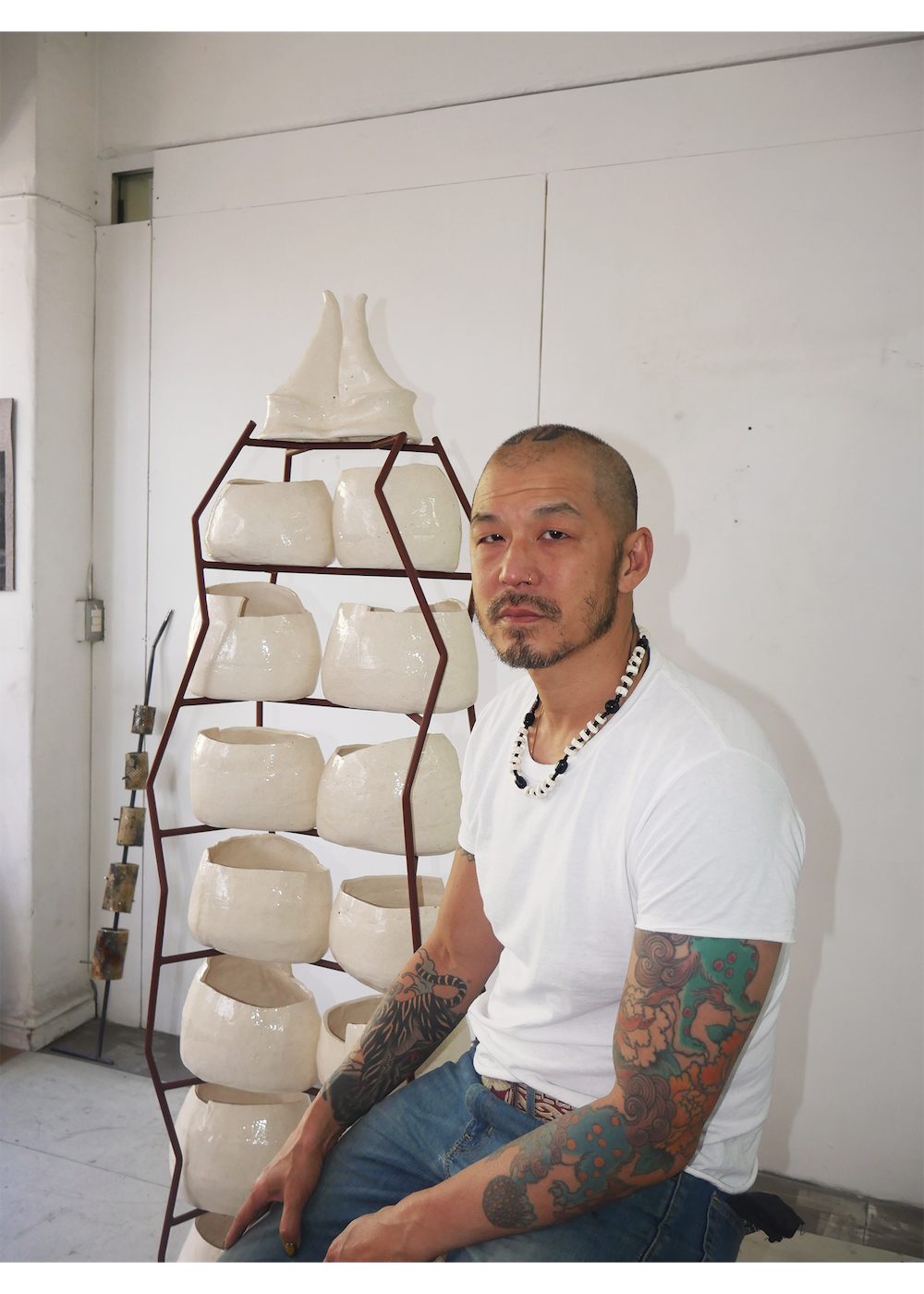
As our call nears the end, I ask Mao where he sees his art in the future. He states, "I want to push the work. I want to embrace the abstraction in the work. It's an impulse for me to rely on aestheticism. And I think that the type of work when you walk into a gallery, and you say, 'What the fuck is that on the floor?' and 'Why is this in a gallery?' That's the kind of abstraction that blows your mind. Like, 'What is this object?' and 'What does it mean to us? Why is it even here? How did it come to exist?'" There's a slight pause, "I want this stuff to get weirder and weirder."
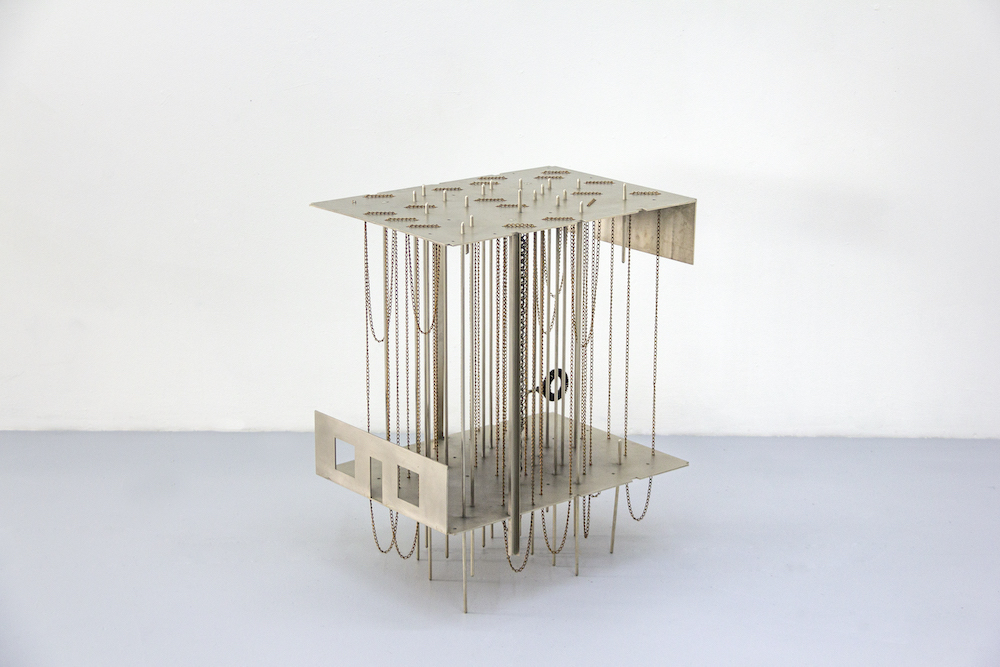
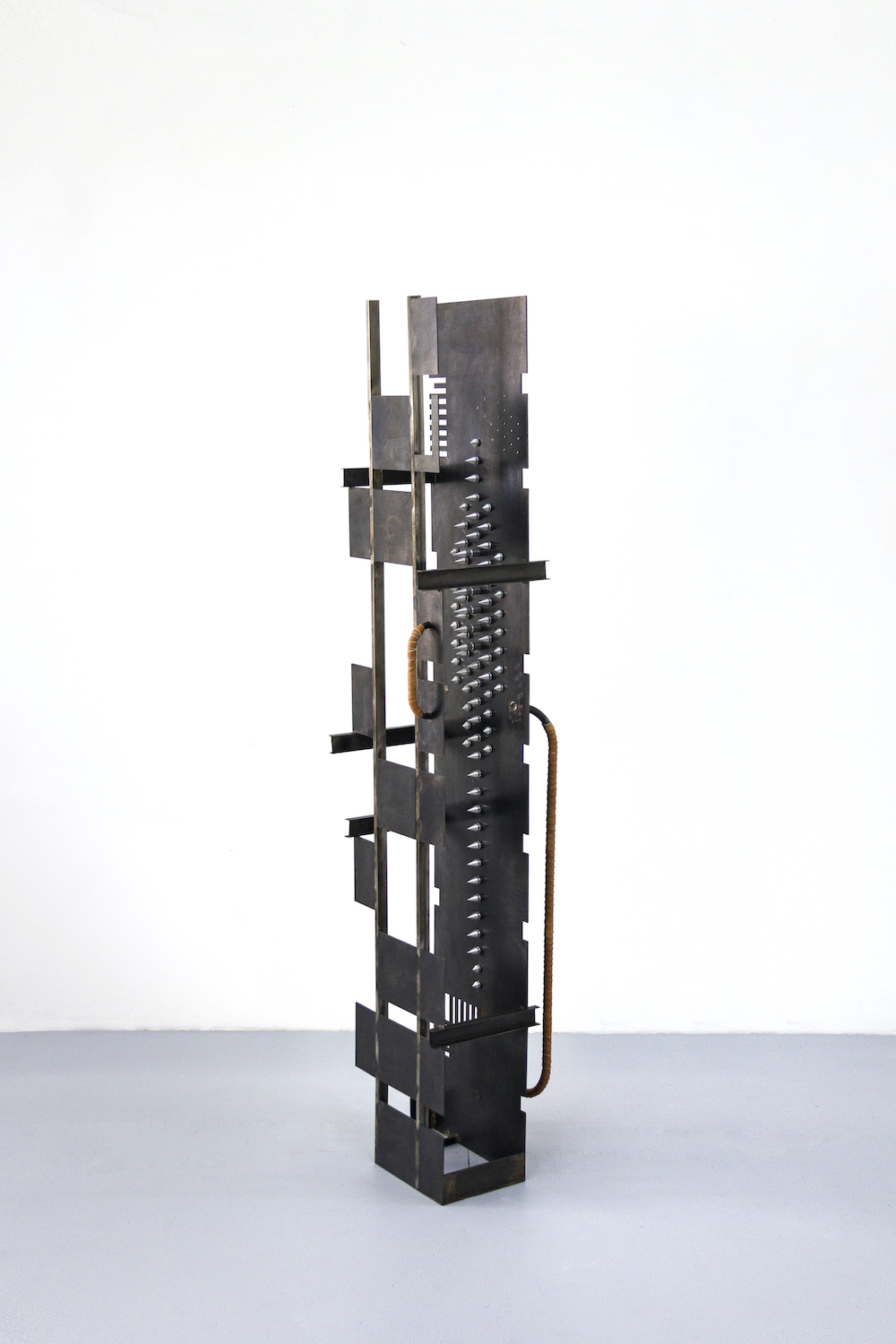
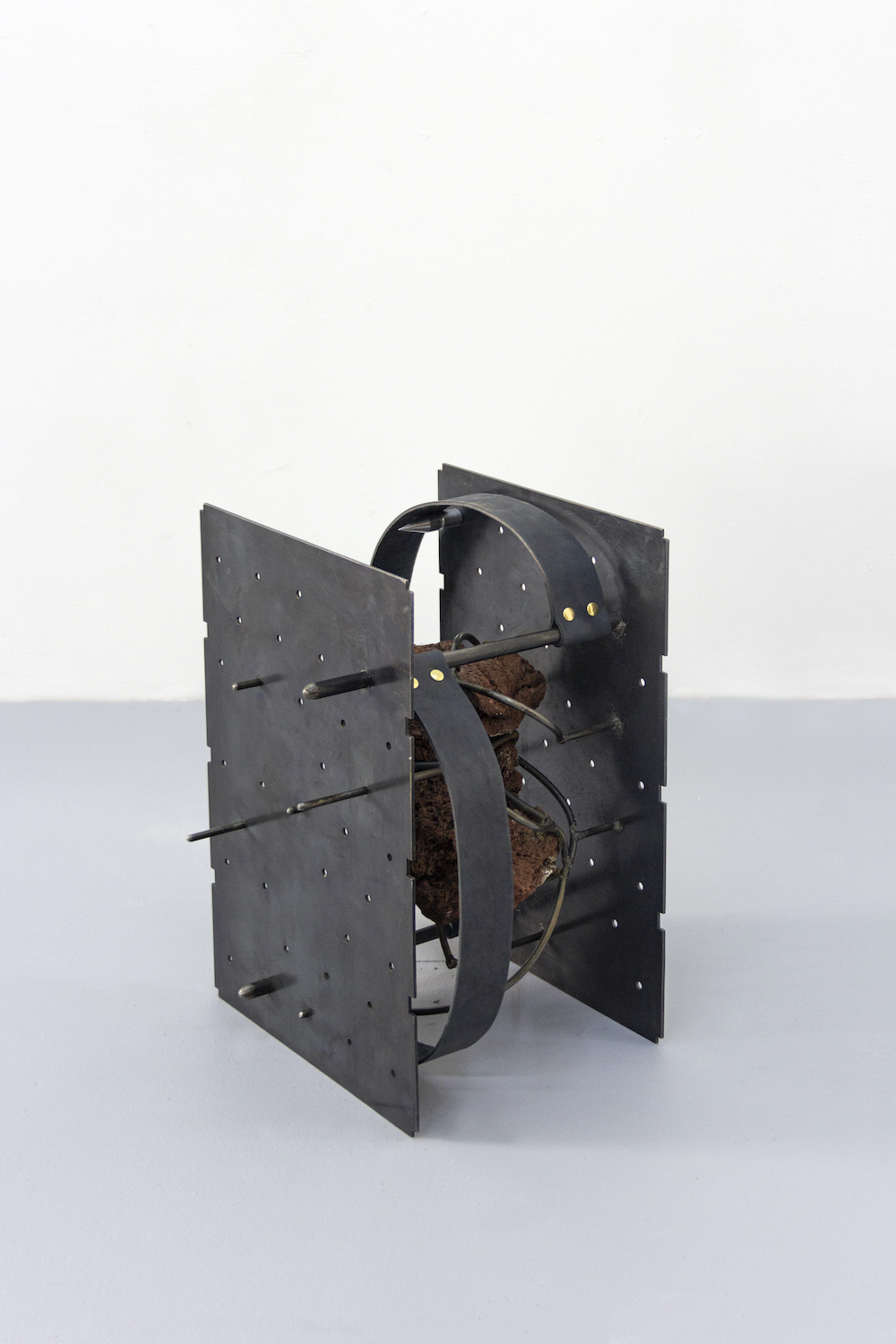
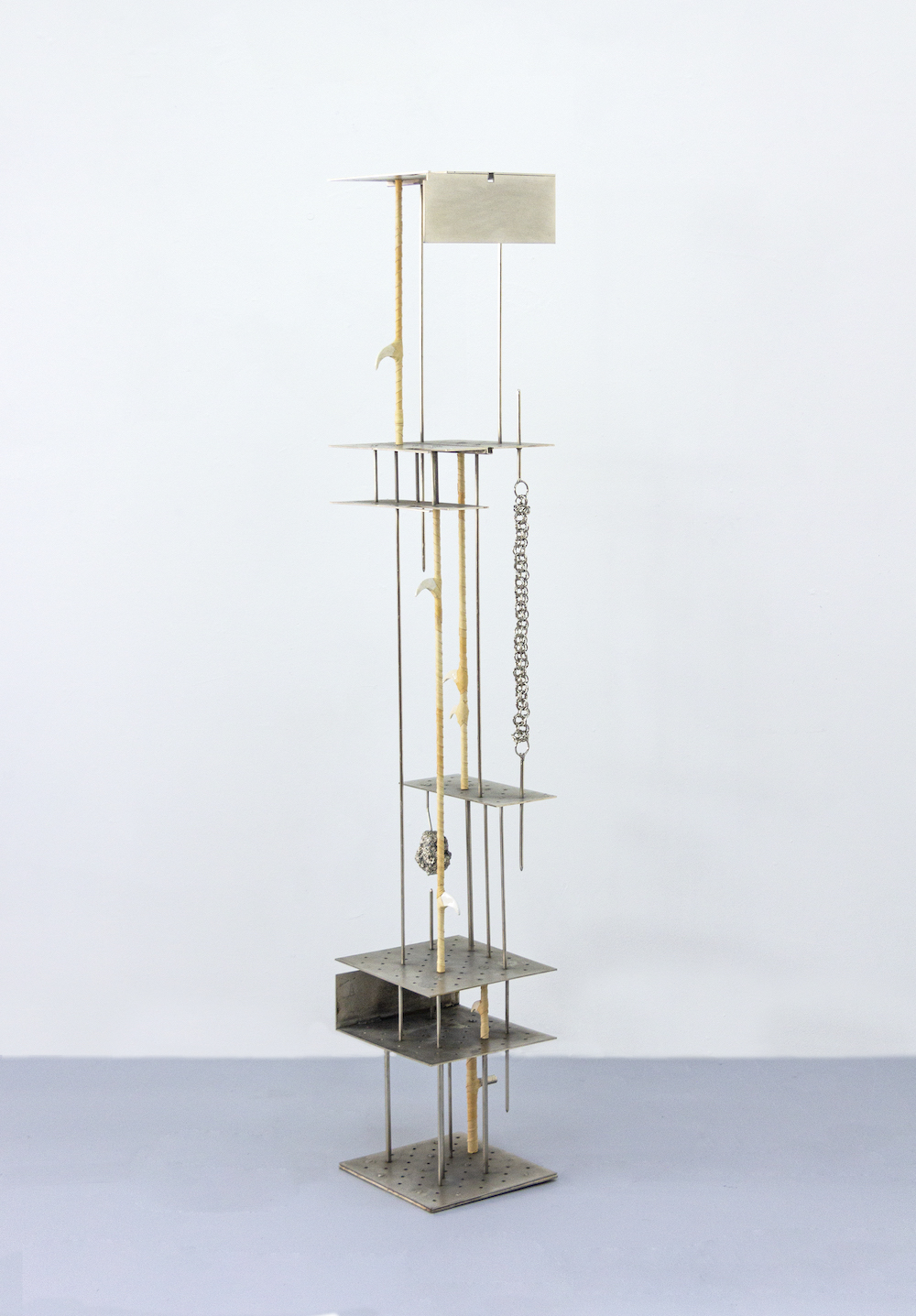
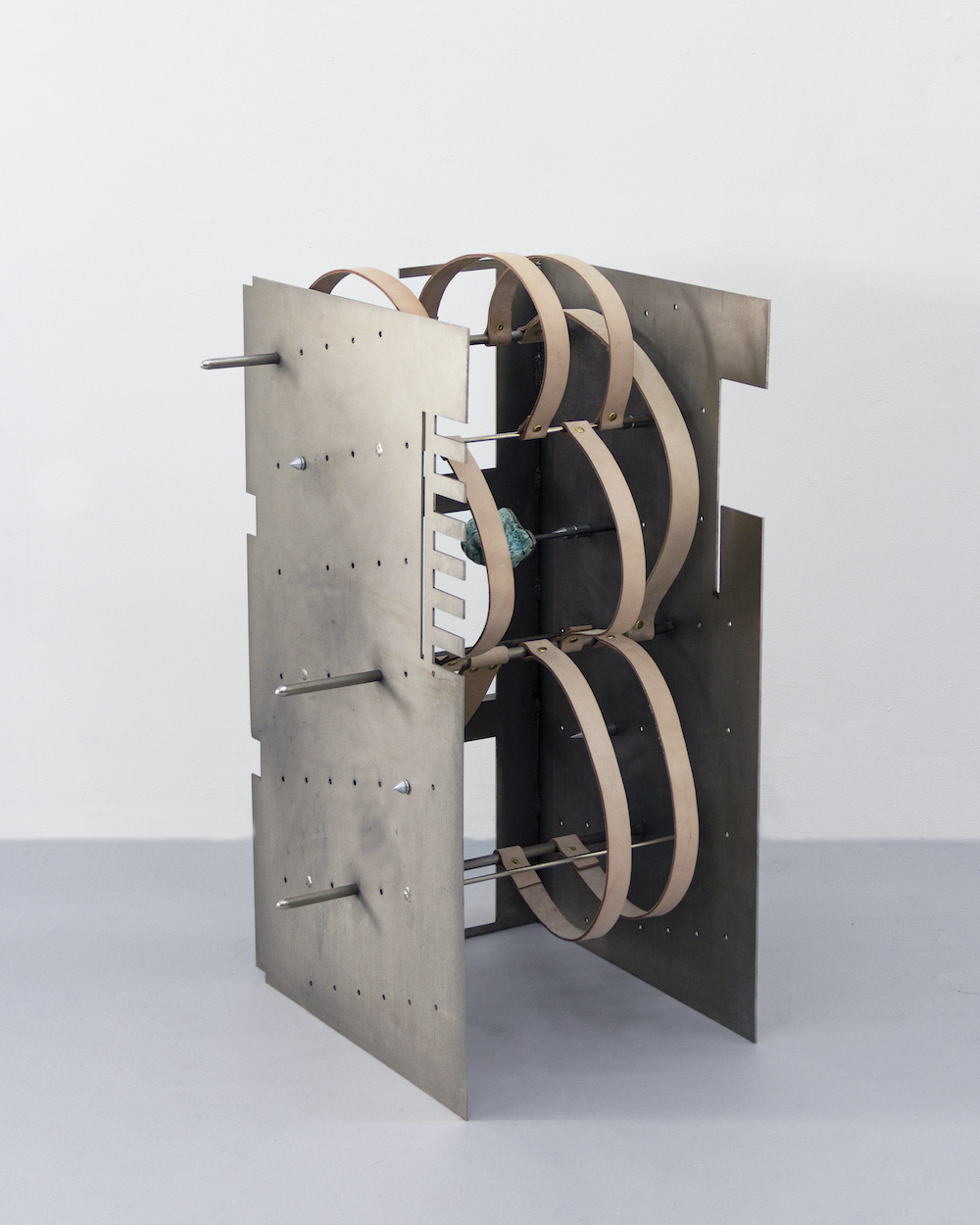
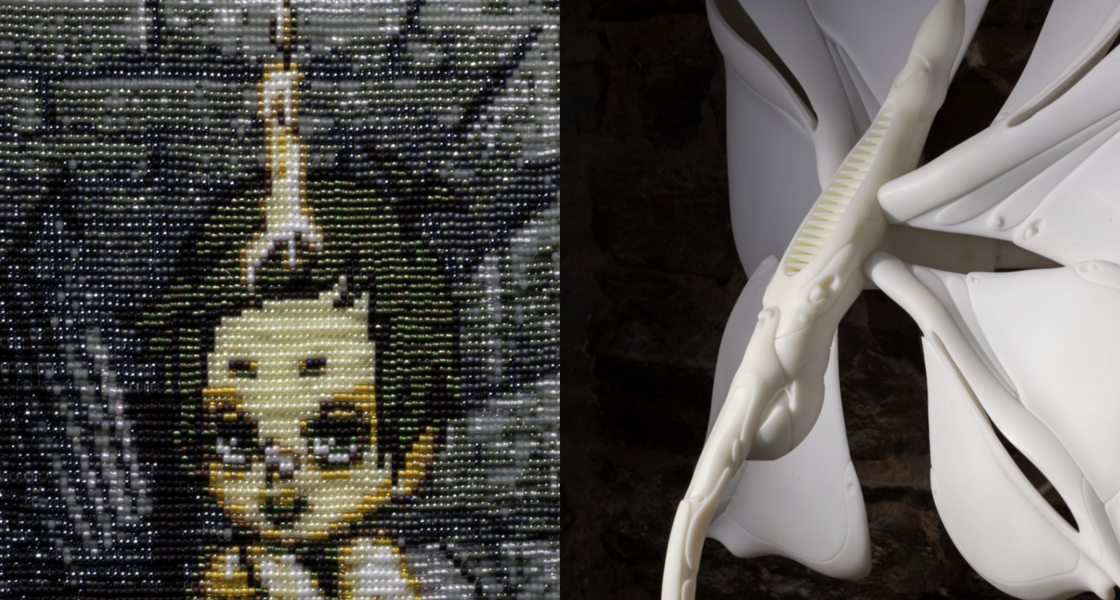
Ultimately, Davis settled on “Secrets to Graceful Living,” unanimously agreed upon by featured artists Anna Pederson and Radimir Koch. On view at ARTXNYC through February 25th, “Secrets to Graceful Living” highlights two artists who, at first glance, work in wildly different mediums. Koch’s contributions are large-scale resin sculptures, digitally sculpted using ZBrush and borne into the physical realm through 3D printing. Pederson, meanwhile, produces small beaded tapestries, meticulously woven using bead looms.
In spite of their superficial differences, both artist collections are informed by digital design. Much of Pederson’s imagery is sourced from the internet, whether it’s stock photos of pylons (see Sentries) or Chibi-style avatars via Gaia Online (see Blessed Avi). Bead by bead, pixel by pixel, Pederson transforms digital images into tangible tapestries. What emerges is uniquely uncanny, an illusion of pixelated perception beyond the screen. “A lot of my work happens on the computer, but I need things to be physical,” Pederson explains. “I could never purely be on the computer.”
Like Pederson, Koch enjoys the process of realizing digital art in physical space, arguably a form of alchemical transmutation in itself. “I want people to experience more than just a flicker,” he tells me. “I want to feel like an avatar in my own little world.” Initially, this desire was largely driven by feelings of anxiety and isolation. Born and raised in Kazakhstan, Koch moved to Colorado with his mother when he was eight years old. “Instead of growing into it, it was like a straight brick wall of America to the face,” he laughs. “Walmarts, Sonic drive-through and all this shit. I was like, what is happening?!”
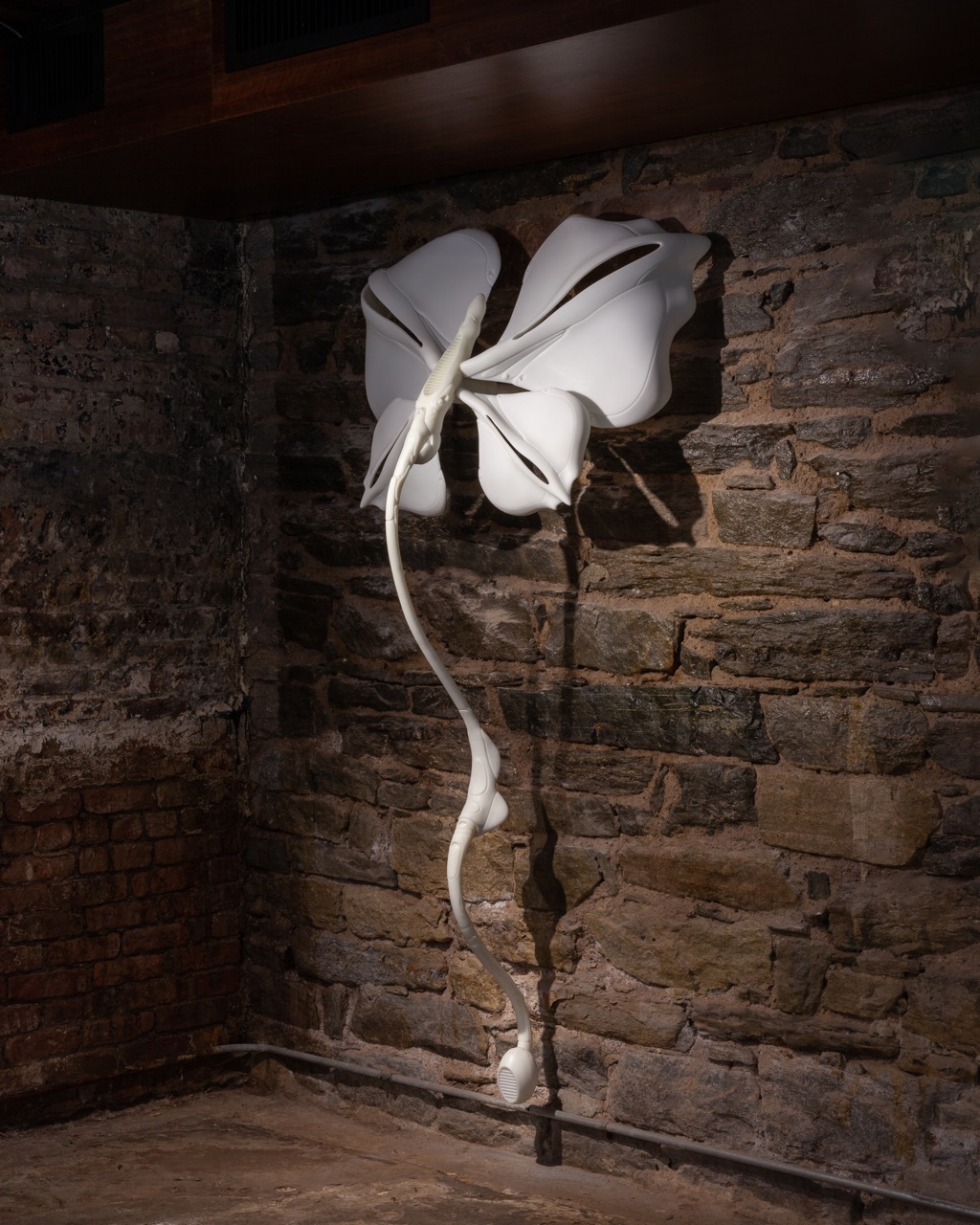
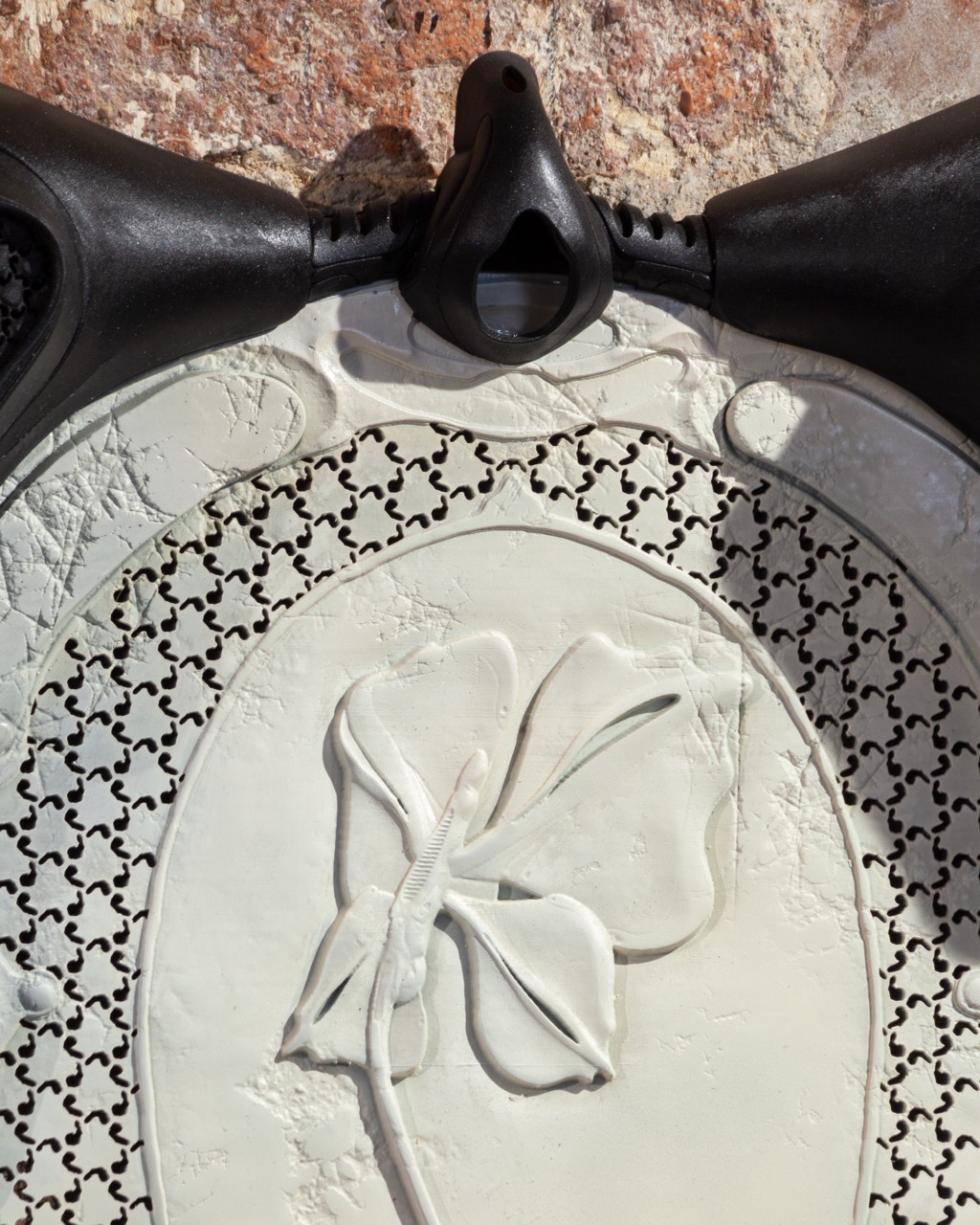
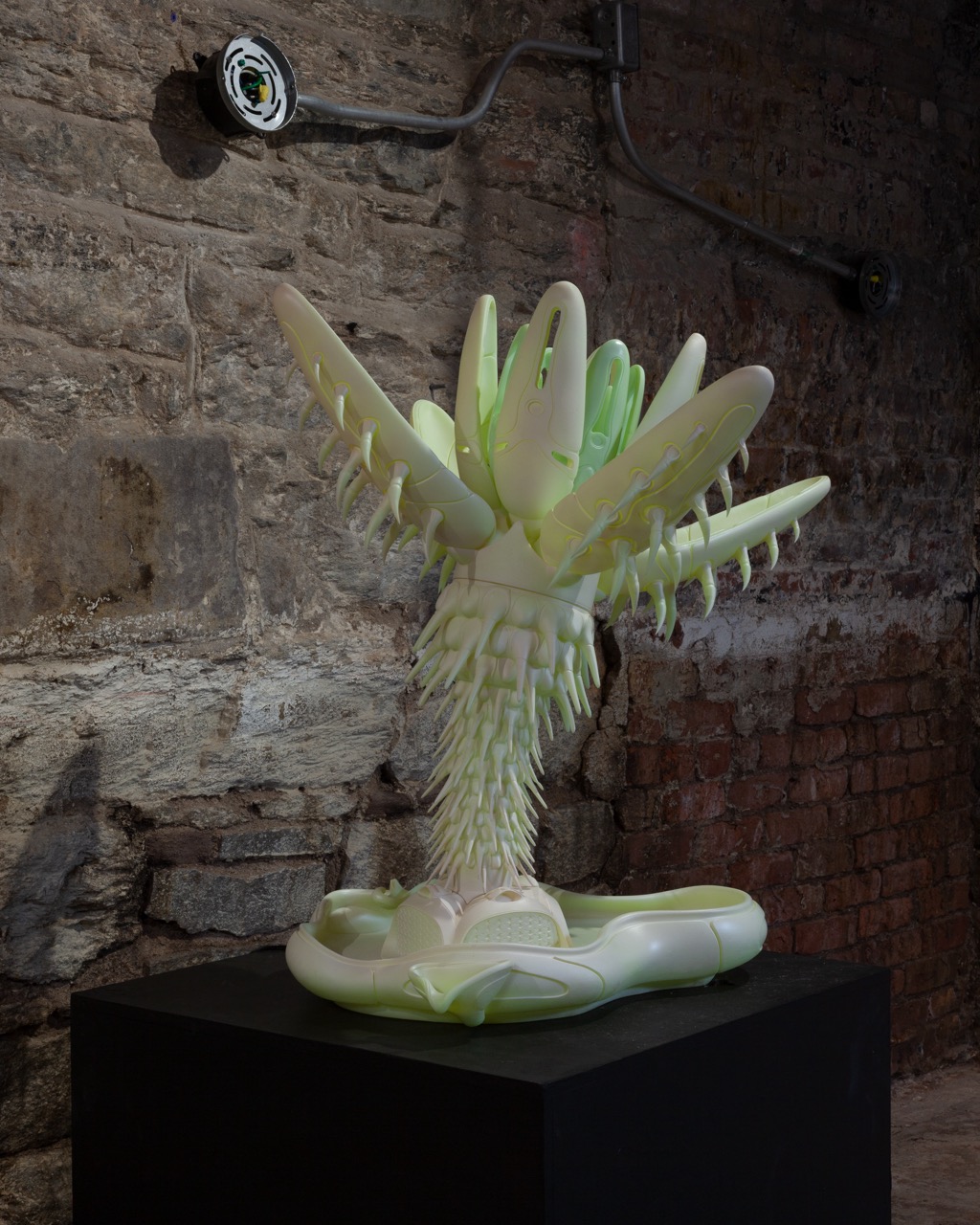
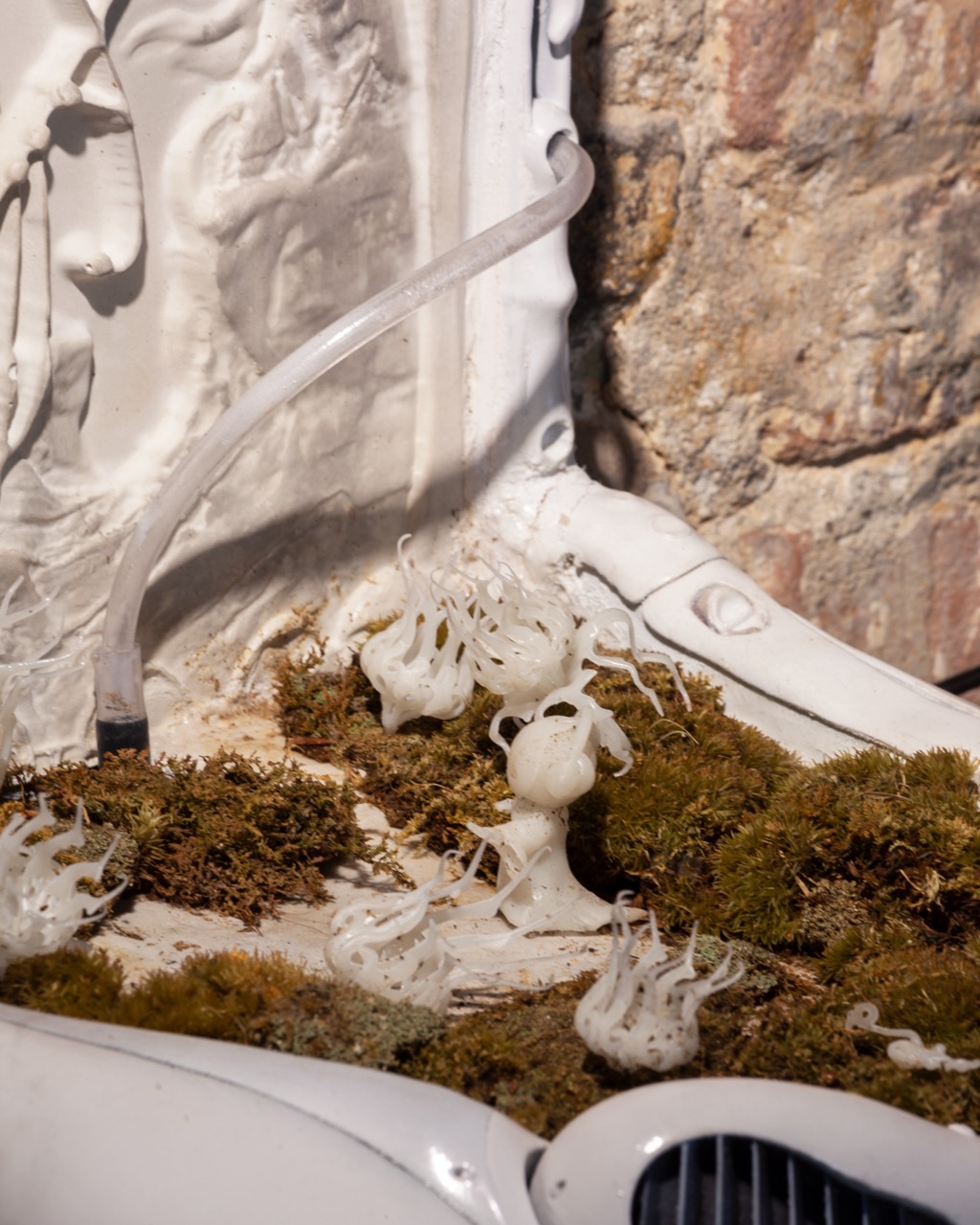
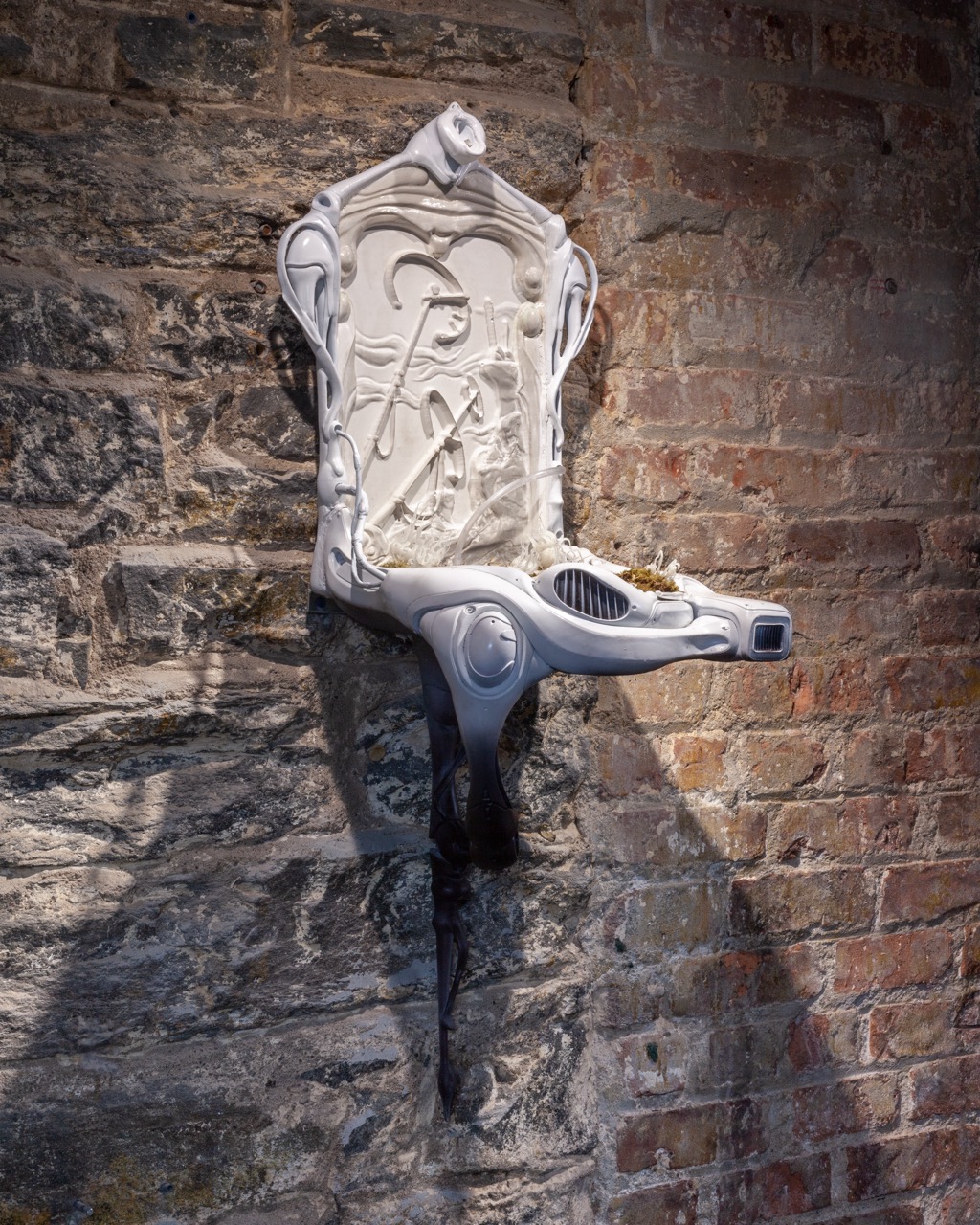

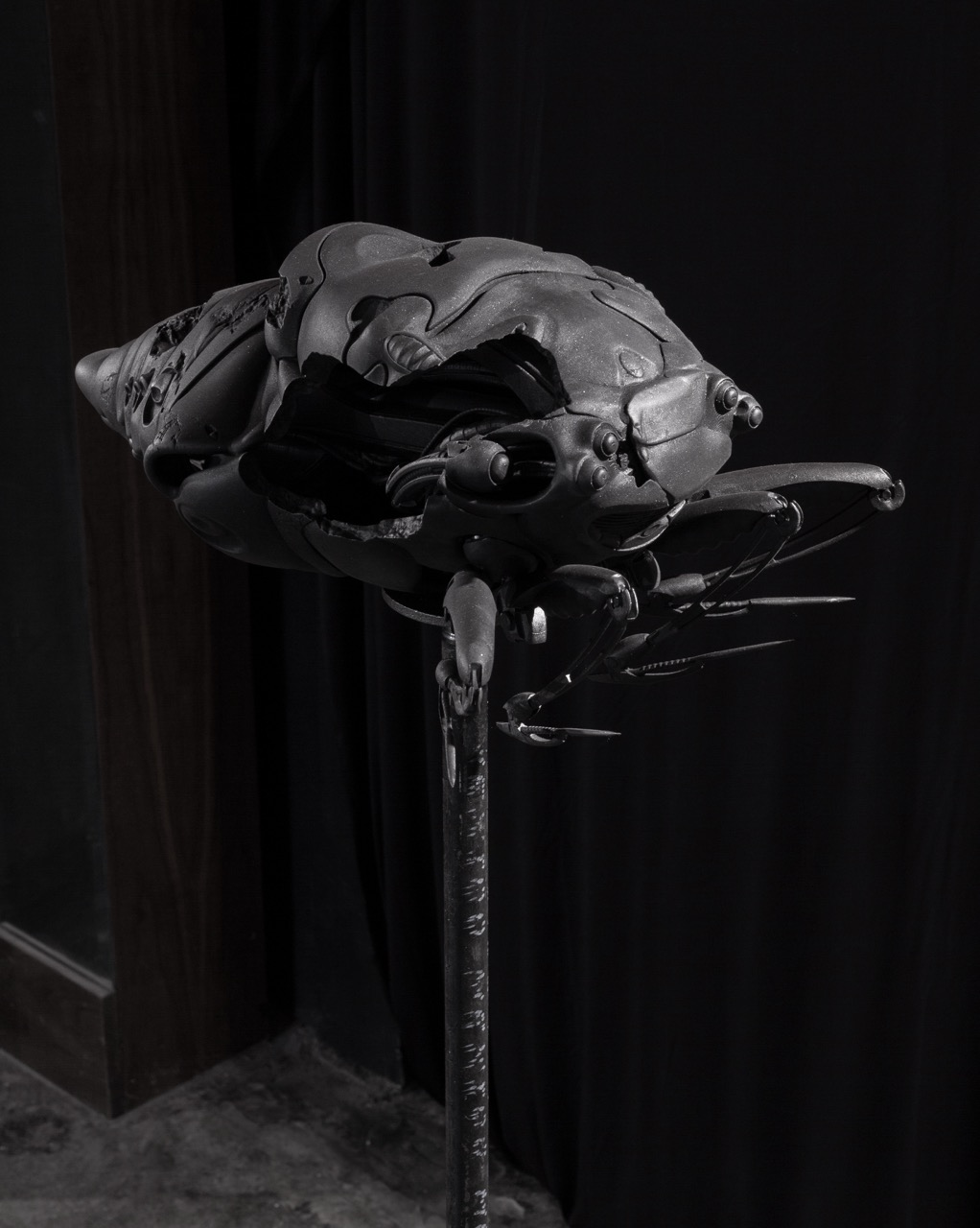
Alienated by the onslaught of Americana, Koch sought refuge in a circle of imaginary friends, sketched into reality in a series of comic books. Inspired by gory 90’s video games like Serious Sam and Grand Theft Auto, Koch upped the ante in middle school, using game engines like RPG Maker to build and modify worlds in the virtual realm. 3D printing, Koch feels, is his way of “bringing it all together,” reanimating digital design in three-dimensional space.
Although his work is the product of man and machine, each one of Koch’s pieces is imbued with organic features. “People usually think of highly advanced 3D-rendering technology as being divorced from the warmth and gentleness of domestic arts and crafts,” his artist notes read. “In these pieces, there is an aura of a growing garden.” This unlikely union is honored in the exhibition text, written by Mitch Anzuoni of Inpatient Press: “There’s a great bloom of machinery and moss...meshing together…” Indeed, this “meshing together” can be seen in works like Eternal Pond 002, which features a bed of tufted moss encased in cold, curving ceramic reminiscent of Marcel Duchamp’s legendary Fountain.
In other pieces, Koch’s tribute to organic design is more subtle. The insectile symmetry of Mekhana 001-003 is simultaneously familiar and alien, seemingly poised to copulate with a strange series of circuits. Mekhana 002 appears again on Exo Relic 002, profiled in textured resin that resembles an aging headstone. In this way, Koch reconciles discord between categorically antagonistic entities: nature and technology, softness and severity, the familiar and the foreign.
Pederson, too, confronts duality in her work. Like Koch’s Floral Relic Pond 001, pieces like Blessed Avi contain oppositional elements of delicacy and danger, inviting yet barbed. In Doomed Avi 1, a feminine avatar gleefully displays an armful of shopping bags amidst a dystopian scene of urban sprawl and earthly decay. In Sentries, a 3D model of a koala is flanked by pylons.
“Industrial imagery has always been a peripheral interest, but for this show I really dug into the Industrial Revolution, researching railroad and agriculture equipment,” says Pederson, who cites American photojournalist Walker Evans and German photographers Bernd and Hilla Becher as visual influences. In a work like Sentries, these industrial elements take on the sort of formidable beauty usually ascribed to geographical features like mountains or waterfalls. “When you assign character and whimsy to things around you, it's a better life,” Pederson tells me, eschewing the prospect of a future characterized by dystopic doom. “Blood-brain barrier aside…a 5G tower kind of looks cool to me.”
Pederson also explores contradictions within the nature of her chosen medium. In pieces like Family Unit and Roxy, she frames internet-inspired imagery with designs that evoke the ancient art of embroidery.

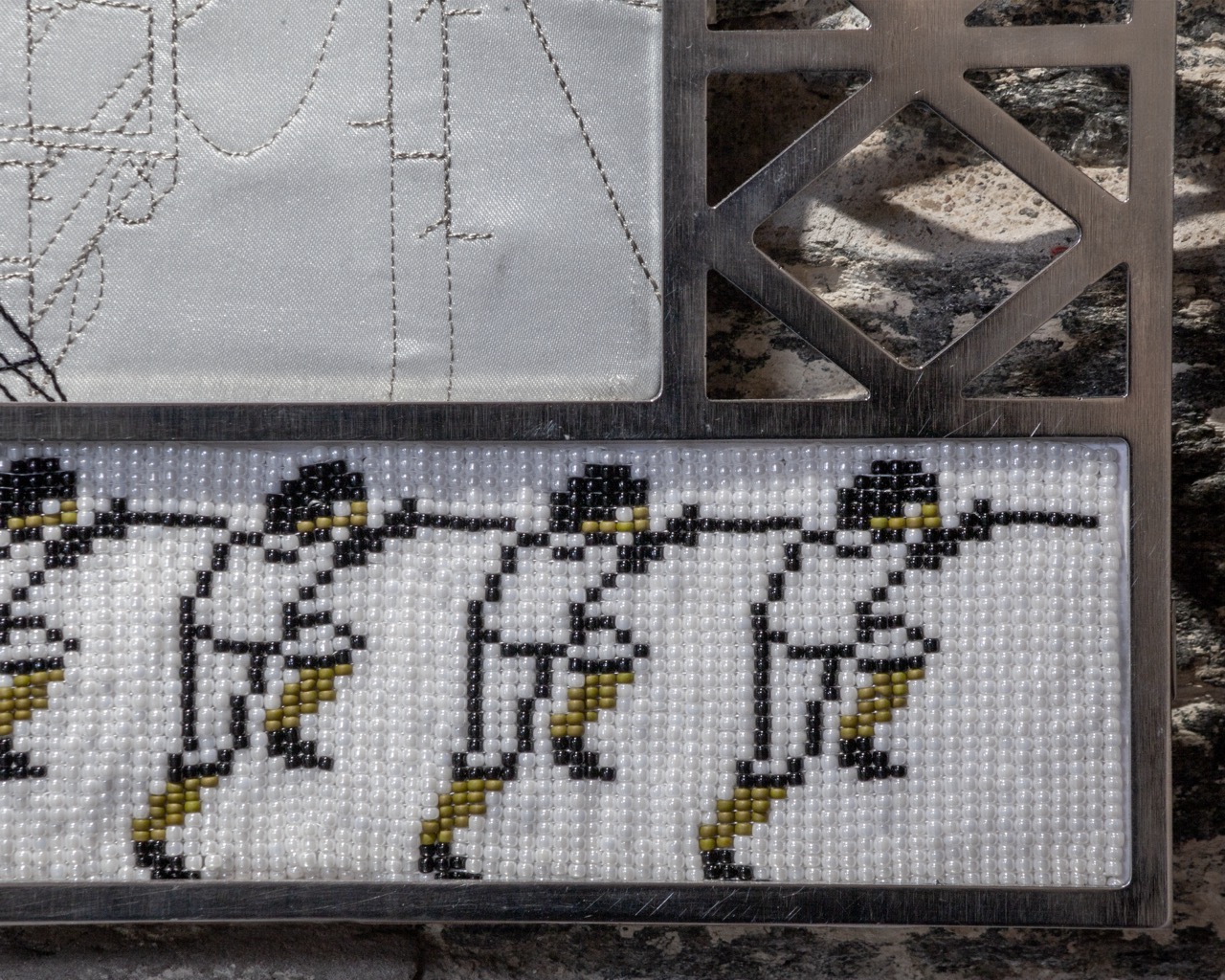
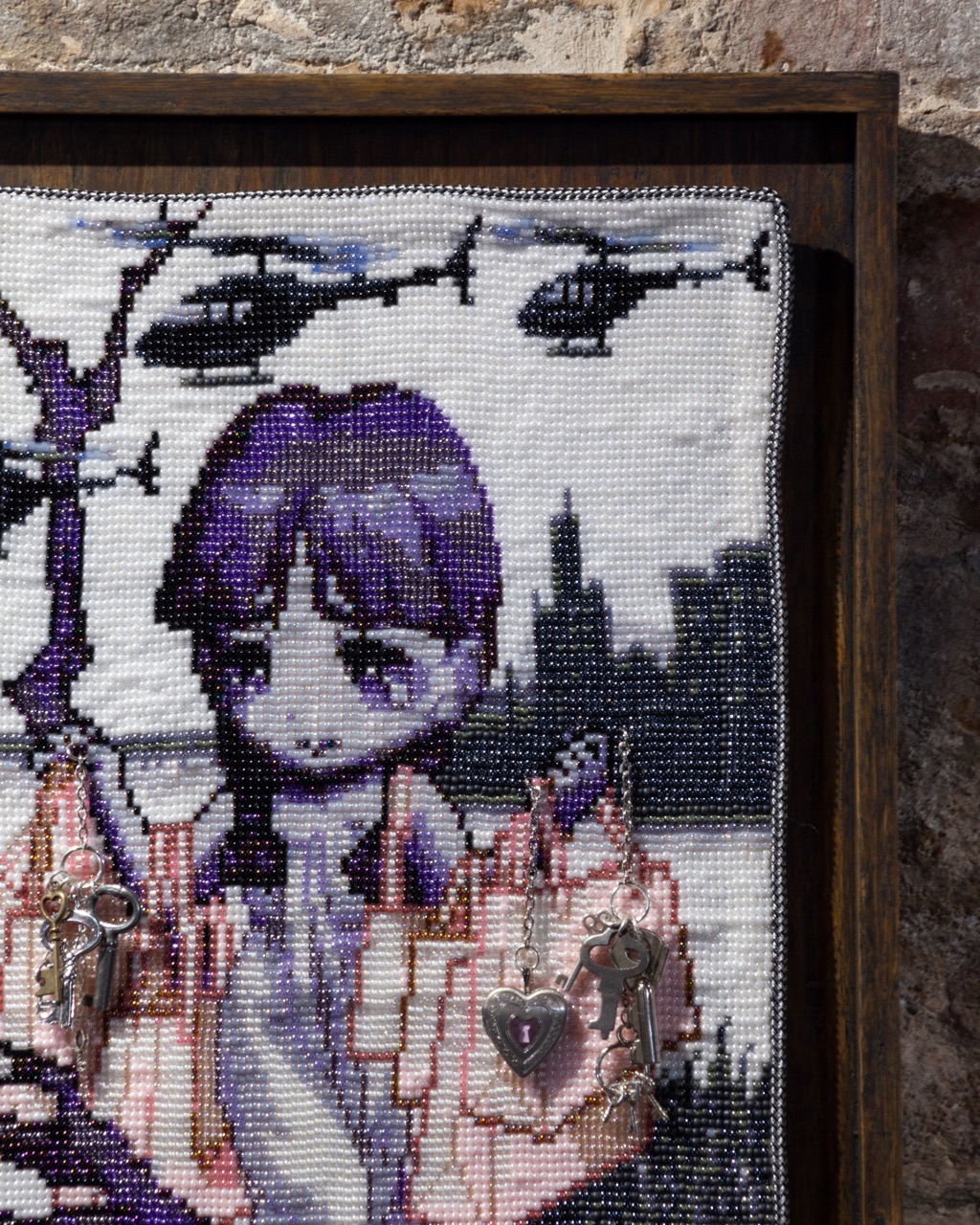
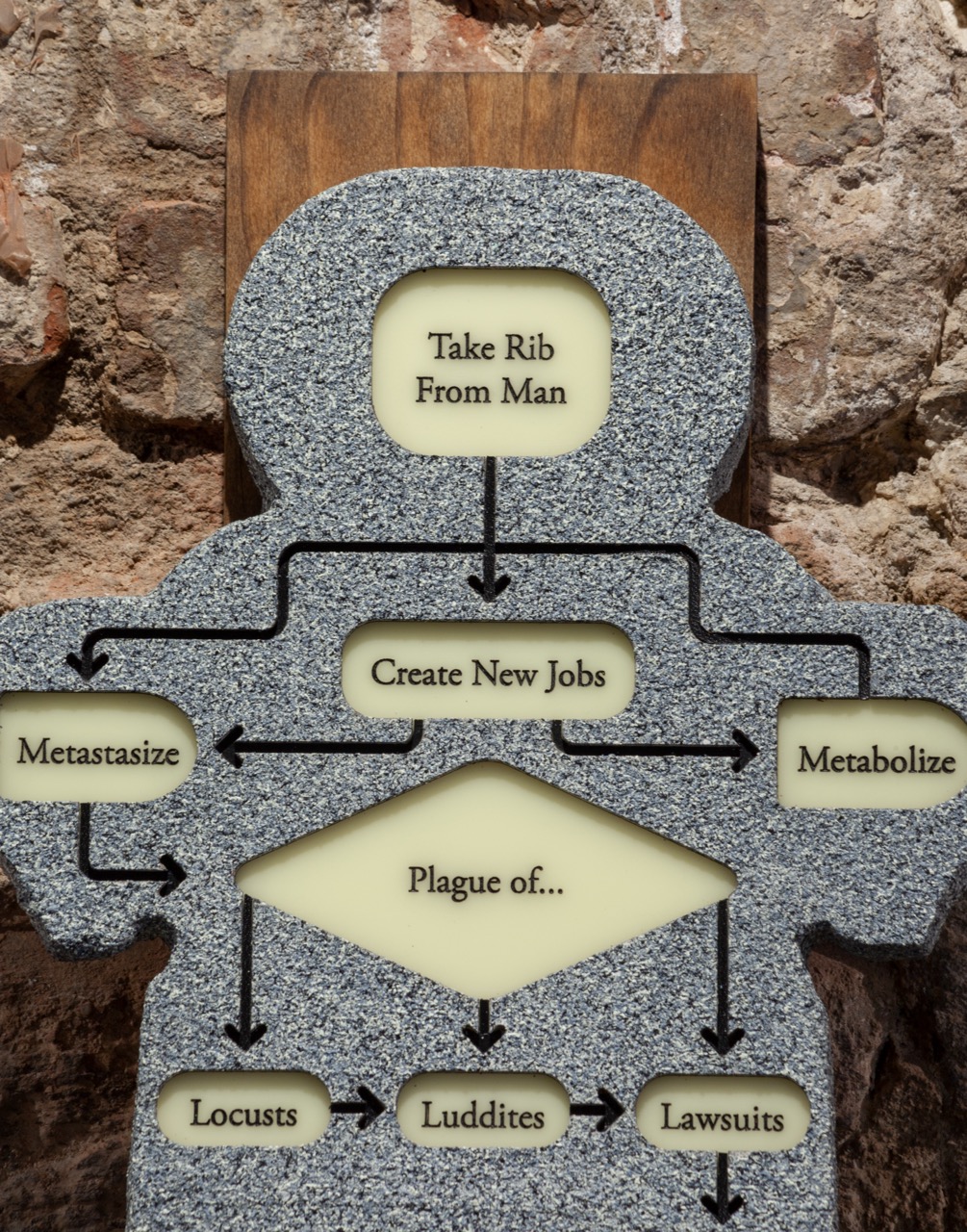
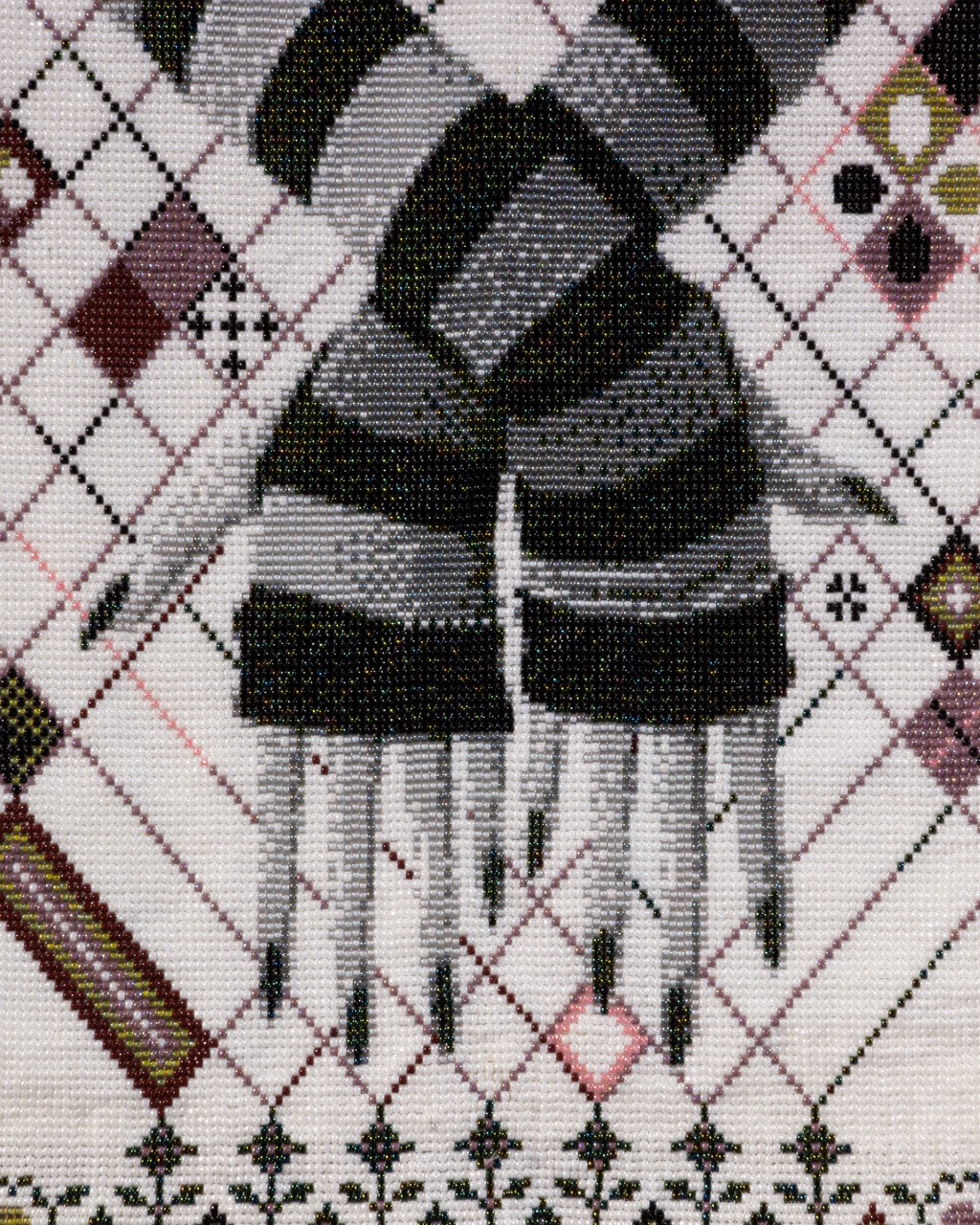

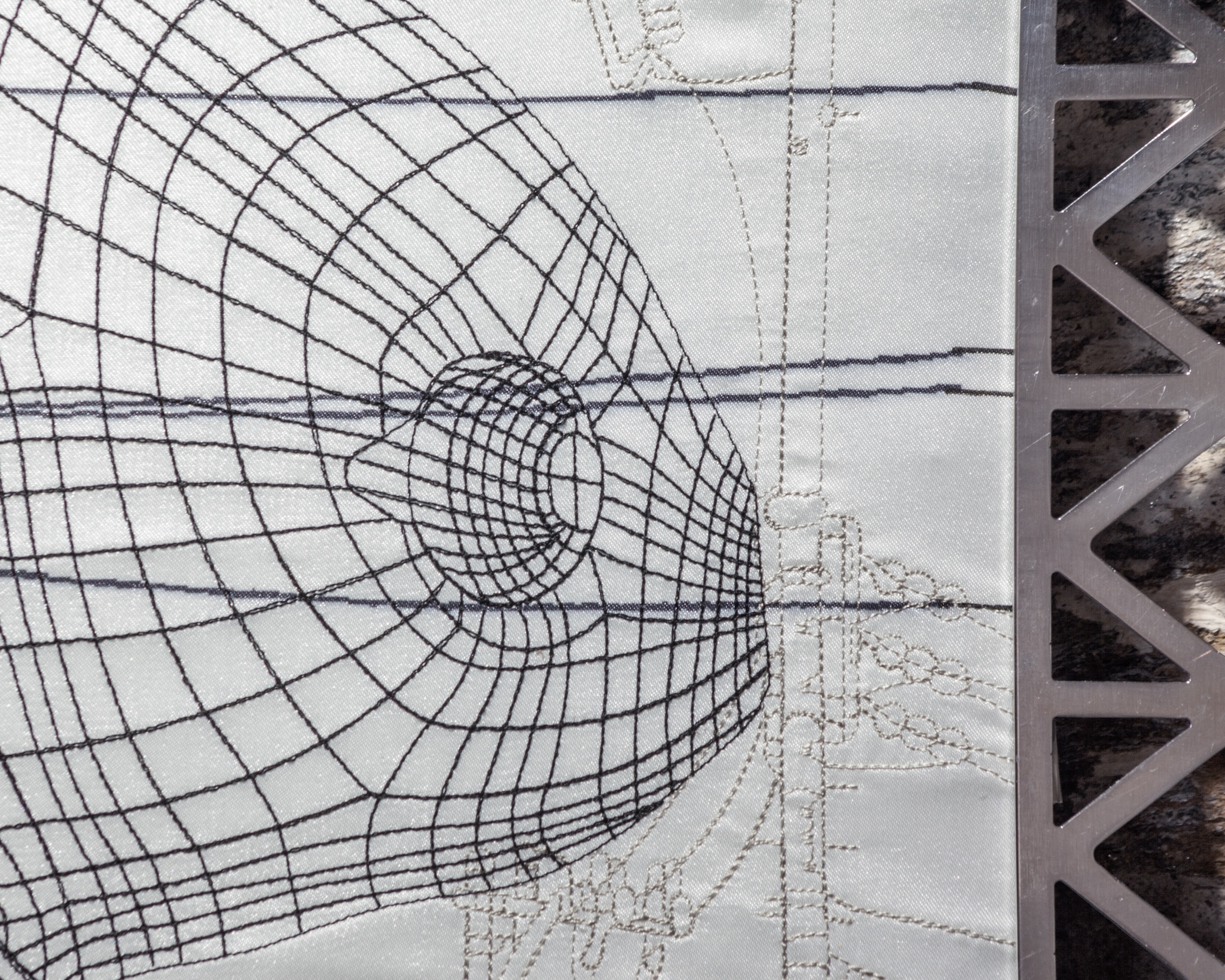
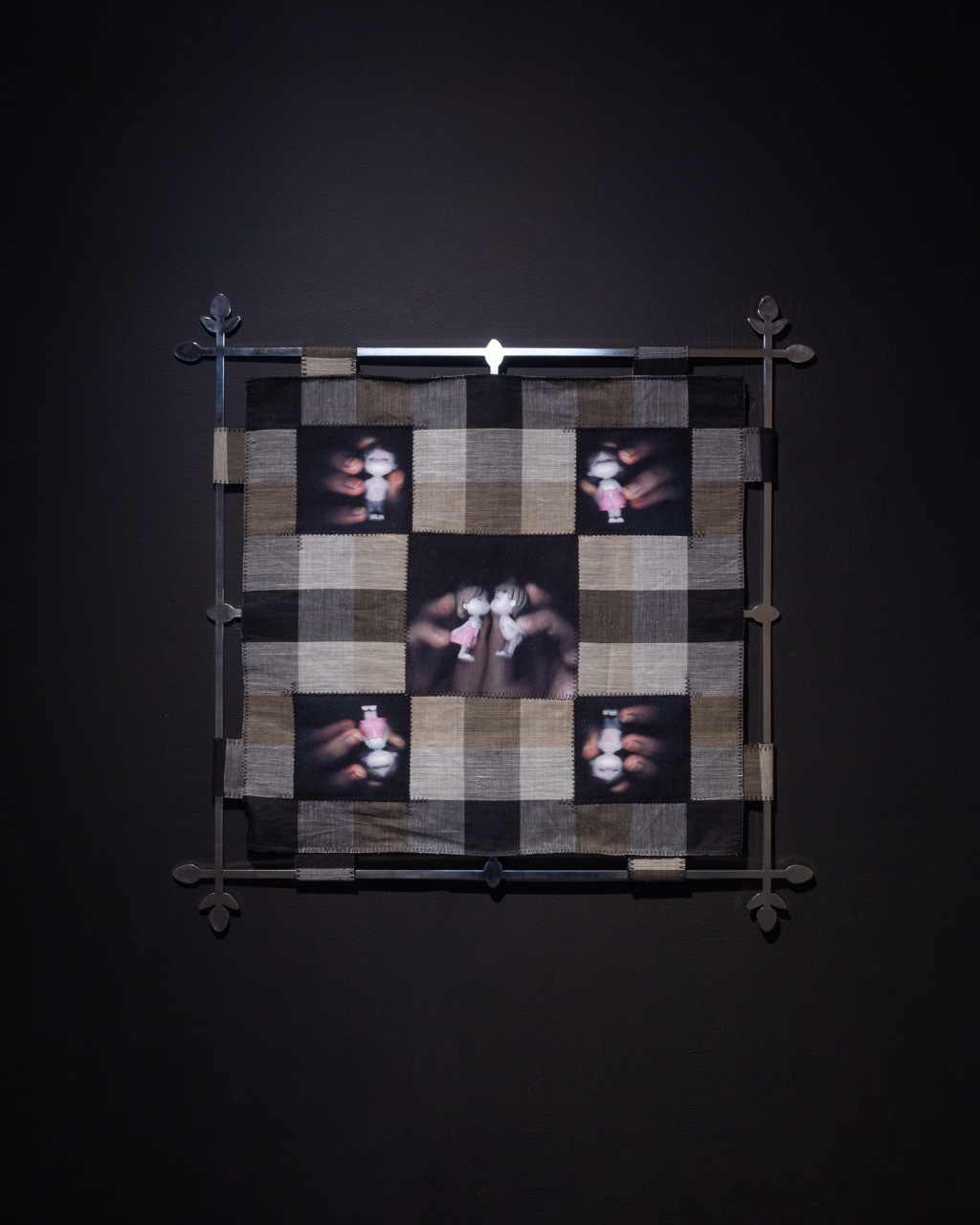
“Secrets to Graceful Living,” in this way, is largely a collection of anachronisms. Both Pederson and Koch toy with the notion of linear time, alternately signaling the past and future in content and form. Koch’s Exo Relic 001 exemplifies this tension. Although it possesses the sheen of futuristic design, it ultimately resembles a cicada, partially chewed away as if in a state of advanced decay. As a symbol, the cicada is fitting, signaling infinite rebirth and resurrection. “A lot of the work is imbued with symbols of afterlife, death, and synchronicity,” Koch states in his artist notes. “It could be post-human, or it could be pre-human.”
While Koch’s work often alludes to spiritualism and metaphysics, Pederson draws on biblical elements. This influence is most prominent in 200 Lbs of American Born Flesh. Pederson’s human-like tablet (her only bead-free work) displays a sort of existential flow chart, starting with the proposition to “Take Rib From Man” before cycling through plagues of locusts, Luddites, and lawsuits. It’s absurdist humor at its best, featuring hyper-contemporary suggestions like “Review Data Policy” and historic George W. Bush quotes like “Now Watch This Drive.”
In light of the Dimes Square-driven glamorization of Catholicism, Pederson assures me that her biblical references are not the product of recent fascination. “I grew up Lutheran and went to church every week until I was 15,” she says. “I didn’t think about it much growing up, but I’m now realizing just how many references there are in art and culture that would have gone over my head if I didn’t go to bible study.” Eternally-relevant, such references amplify the show’s pervasive atmosphere of being lost in time.
Evoking the ancient practice of alchemy through echoed themes of timelessness, transmutation, and the union of opposites, “Secrets to Graceful Living” transcends cheap shots at technocapitalism. To claim it’s devoid of messaging isn’t accurate either, however. Alyssa Davis has clearly allied herself with the gray area, an infinitely richer well for the future of art.
“Secrets to Graceful Living” is on view at ARTXNYC through February 25.
